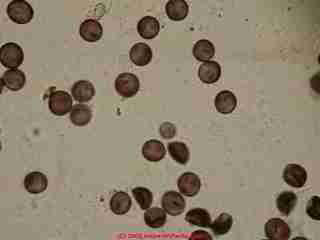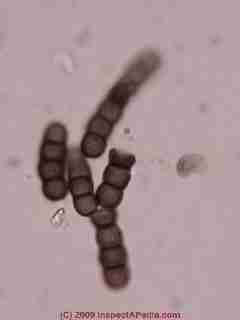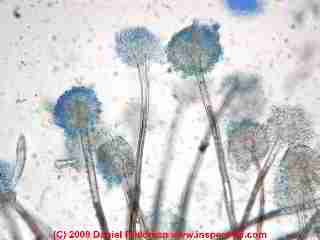 Mold Atlas of Indoor Clinical Mold, Pathogens, Allergens & Other Indoor Particles
Mold Atlas of Indoor Clinical Mold, Pathogens, Allergens & Other Indoor Particles
- POST a QUESTION or COMMENT about the health effects of individual mold genera/species: which building molds cause or contribute to which illnesses?
What are the health effects of specific kinds of mold?
Here is a photo-Atlas of common building mold contamination & other indoor particles that describes the medical health effects of mold and indoor particles such as animal dander, cat, dog, mouse dander and dust, asbestos, fiberglass from insulation or other sources, dust mite fecals, house dust, insect fragments, insect hairs, insect fecals, talc, and ultra fine sub micron particles.
Dust from the world trade center collapse, and other particles have entries in this list.
InspectAPedia tolerates no conflicts of interest. We have no relationship with advertisers, products, or services discussed at this website.
Alphabetic List of Molds and Airborne Particles With a Summary of Particle Toxicity and Clinical References
This guide to harmful indoor mold contaminants contains microphotographs of building mold observed in air, surface, or vacuum samples collected during our building investigations.
Citations are collected from a variety of authoritative sources, primarily the authoritative
"Clinical Mold and Toxic Particle References" cited in the extensive bibliography at the end of this document. References to online resources are included.
Index to Building Mold Genera/Species in This Document
A - B - C - D - E - F - G - H - I - J - K - L - M - N - O - P - QR - S - T - U - V - WXYZ
Directories of 6 atlases or indices of building mold
- BLACK MOLD, HARMLESS - Photos of of often recognizable, usually harmless or cosmetic black mold on wood
- MOLD APPEARANCE - WHAT MOLD LOOKS LIKE - Photos of what mold looks like in buildings, organized by mold color and appearance.
- MOLD APPEARANCE - STUFF THAT IS NOT MOLD - Photos of material that is not mold but is sometimes mistaken for mold
- MOLD ATLAS & PARTICLES INDEX, Pathogens, Allergens and Other Indoor Particles - actual and possible medical health effects of Mold (separate online document)
- MOLD FREQUENCY in BUILDINGS - Table of what mold genera/species are frequently found in indoor mold tests.
- MOLD GROWTH ON SURFACES, PHOTOS - Photos of what mold looks like in buildings on more than 100 surfaces, organized by mold growth on various kinds of building surfaces and contents or items found in buildings. Mold in situ.
- MOLD GROWTH on SURFACES, TABLE OF - Summary table of what mold genera/species are frequently found on various building surfaces and materials
- MOLD BY MICROSCOPE - Mold under the microscope - photo identification of the most common indoor molds found in buildings
- MOLD in the PETRI DISH, PHOTOS - what mold looks like on culture plates or in culture-type mold test kits
- MOLD RELATED ILLNESS SYMPTOMS - Mold Related Illness: Index of Symptoms. Readers should not rely on this document for medical diagnosis and instead should consult with their physician or with a specialist such as a medical toxicologist
NOTICE: This Mold and Airborne Particle Toxicity Atlas (© 2012 - 1985 DJF All Rights Reserved) is organized alphabetically by mold genera/species or other particle name. For each mold genera/species or for other particles, known medical, allergenic, pathogenic, or toxicological effects are listed.
Research on the toxicology of mold and other indoor particles is incomplete and people may express a wide range of symptoms and health complaints which may appear to be related to mold and other indoor contaminants notwithstanding the lack of confirming research.
Citing this document: Readers wishing to provide citations of the contents of this atlas may do so by citing this web page InspectAPedia.com/mold/Mold_Particle_Atlas.php or where the original texts are available those should be cited.
In some cases where I have been unable to locate an authoritative source of medical information for certain particles I may express an opinion about the possible effects based on field observation and client complaints but such opinions are labeled as such and should not be considered authoritative. Suggestions and criticism are welcomed..
Information About Individual Mold Genera/Species found in Buildings
A
Absidia sp. "A zygomycete fungus. Reported to be allergenic. May cause mucorosis in immune compromised individuals. The sites of infection are lung, nasal sinus, brain, eye and skin. Infections may have multiple sites." U. Minn.
[NOTE: Citations labeled U. Minn. refer to the University of Minnesota Department of Environmental Health and Safety - see www.dehs.umn.edu/ --DJF]
Acrodictys sp. - -- no medical information was located, i.e. this fungus is not cited in common clinical fungi references which concern fungal species which are pathogens. Where this mold has been found observers should be alert for other fungal species as mold-conducive conditions are present.
This fungus may be a wood-rotter.-- DJF [NOTE: Citations or comments with the "--DJF" suffix represent the author's opinion and without further research may not be authoritative.]
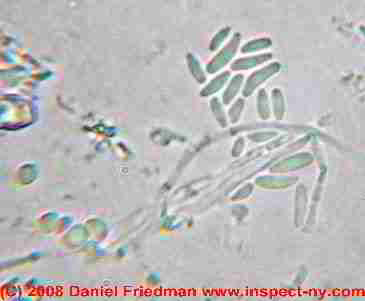
Acremonium sp. (Cephalosporium sp.) - "Reported to be allergenic.
Can produce a trichothecene toxin which is toxic if ingested. It was the primary fungus identified in at least two houses where the occupant complaints were nausea, vomiting, and diarrhea.
Asexual state of Emericellopsis sp., Chaetomium sp., and Nectripsis sp. It can produce mycetomas, infections of the cornea and nails." - U. Minn. [See Gliomastix sp. discussion.] Acremonium species are found in soil, sewage, and on vegetation and food and are an airborne spore.
Human infections with Acremonium used to be rare but are reported more frequently, associated with hyalohyphomycosis (fungal tumors or masses, or eye infections).
Acremonium mold has been associated with systemic infections: endocarditis, osteomyelitis, arthritis, and pumonary infections as well as infections of skin, nails and hard palate.
This fungus has also been reported to colonize on contact lenses - Fundamentals of Diagnostic Mycology, Fisher & Cook 1998, excerpted by DF.
Alternaria sp - [Very common mold, widespread outdoors.-DF] A very common allergen with an IgE mediated response. Outdoors it is common in soil, seeds, and on plants. Indoors it is often found in carpets, textiles, and on horizontal surfaces in building interiors. Often found on window frames.
 The large spore size of Alternaria mold conidiophores suggests that the spores
from this fungi will deposited in the nose, mouth and upper respiratory tract.
The large spore size of Alternaria mold conidiophores suggests that the spores
from this fungi will deposited in the nose, mouth and upper respiratory tract.
It may be related to baker's asthma. It has been associated with hypersensitivity pneumonitis. The species Alternaria alternata is capable of producing tenuazonic acid and other toxic metabolites which may be associated with disease in humans or animals.
Alternaria sp. can be a common cause of extrinsic asthma (immediate-type hypersensitivity: type I). Acute symptoms include edema and bronchiospasms; chronic cases may develop pulmonary emphysema. -- U. Minn. Dept. of Environmental Health & Safety.
A. alternata is an outdoor mold, considered an important allergenic mold. -- labspec.co.za 8/01 -df -- The genus contains 44 species of which most are plant parasites, but a few species are ubiquitous and are also frequently soil-borne.
A. alternata is the commonest of these. Although usually seen as saprophytic contaminants, Alternaria species are recognized causative agents of mycotic keratitis and phaeohyphomycosis.
Clinical manifestations include cutaneous infections, paranasal sinusitis, osteomyelitis and peritonitis in patients on continuous ambulatory peritoneal dialysis (CAPD). Clinical group: Opportunistic mycoses Mycosis: Phaeohyphomycosis -- U. Adelaide
Amerospores - One-celled fungal spores generally round to oval with a length/width ratio < 15:1 and without significant curvature or ornamentation.
Spores are placed in this "amerospore" general class when the sample in which they are found lacks additional identifying characteristics and when the spores do not by size and ornamentation appear to be commonly-recognizable instances of Penicillium, Aspergillus, or Basidiomycetes.
If large amounts of any un-speciated fungi are present indoors it would be prudent to clean or remove the mold using methods that protect the worker as well as protecting the environment from spread of moldy dust and debris. If only incidental occurrences of amerospores are found in a sample they are not considered significant.
Animal Dander: According to the US EPA and other expert sources, [paraphrasing document cited below] animal skin flakes, urine, feces, saliva, and hair can trigger asthma or other allergic reactions.
Dogs, cats, chinchillas, mice, rabbits, rats, other rodents, squirrells, and other mammals can trigger asthma/allergic reaction in people who have an allergy to animal dander.
Proteins in these materials have been reported to sensitize people and can cause allergic reactions or can trigger asthma episodes in people who are already sensitive to animal allergens.
Our laboratory photographs (below) show domestic rabbit hair (below left) and rabbit dander (below right).
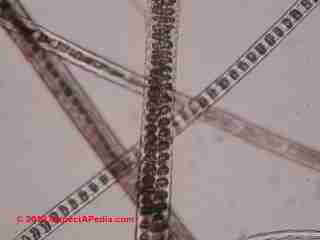
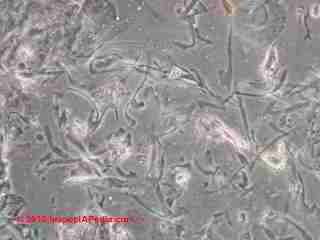
The most effective method to control animal allergens is to remove the animal from the building, followed by thorough [professional] cleaning.
The EPA indicates that allergens are found months after a pet (or mouse problem) has been removed. I often find significant levels of allergens in buildings where the source animal(s) have been gone for years if professional cleaning has not been performed.
Even when cleaning is thorough I can find allergen materials remaining.
While adequate cleaning after animal removal is usually successful, for people who are extremely sensitive even low remaining allergen levels may be a problem, particularly if stirred or distributed by HVAC equipment or other sources of air movement.
After removing the pet or pest animal(s), the following measures are recommended: thorough professional duct cleaning, commercial steam cleaning of some materials, dry-cleaning or very hot water laundering of clothing, freezing of small items (to kill dust mites), washing and HEPA vacuuming of interior surfaces. Note that ordinary vacuum cleaning is not effective and may make matters worse for sensitive occupants as it causes allergenic particles to become airborne.
Animal dander particles can be less than 1 micron in size and thus may remain airborne for more than 8 hours after vacuuming. Many sources offer advice aimed at keeping a pet in the home: keeping pets out of bedrooms and other sleeping areas and keeping these areas isolated from pet-occupied areas, keeping pets away from fabric-covered furniture, frequent washing of pets, frequent house cleaning using the extensive means described above are all listed. (No expert sources other than drug suppliers cite using medication as the first choice in addressing pet allergies.)
However most expert sources agree that " - the most effective method to control exposure to animal allergens is to keep your [building] pet [and animal-pest] free." -- Reference and source for both paraphrasing and quotations above:
- http://www.epa.gov/iaq/asthma/triggers/pets.html (keep pets out of building and other advice)
- www.allergynursing.com/questions/pets.html (keep pets outside),
- www.cheshire-med.com/programs/pulrehab/asthma/alltrigg.html , (remove pets from building)
- http://allergy.mcg.edu/advice/pets.html , (avoid pets that have fur),
- www.nwasthma.com/resources/mitesInfo.htm ,(avoid warm-blooded animals),
- www.webmd.lycos.com/conent/article/1728.75135 (keep dogs out of the house)
- Biological Pollutants in Your Home, original source U.S. EPA - http://web.archive.org/web/20050923142014/http%3A//www.epa.gov/iaq/pubs/bio_1.html
- www.epa.gov/iaq/biolobic.html , (vacuuming can increase airborne allergens),
- http://www.iaq.iuoe.org/iaq_htmlcode/iaq_news_clips (air purifiers don't work) and
- www.cuhumane.org/topics/allergh.html (if refuse to say goodbye to pets, keep out of bedroom)
Arthrinium: common on dead plants and grasses. Uncertain identification.
Arthrographis: "This fungus causes a pink stain in heartwood and sapwood of pine, birch, hemlock, spruce, fir, oak, and Douglas Fir - ; Wang &al (1982) judged A. cuboidea to be a "non-soft rotter," [it does not rot softwoods] Wang & Zabel, "Identification Manual for Fungi from Utility Poles" 1990.
Possible association with Onychomycosis (associated to A. kalrae) according to fungusweb.utmb.edu 5/10/2000 [A. kalrae=Oidiodendrum.] fungusweb.utmb.edu/mycology/arthrographis.html . A. cuboidea is one I have found in buildings. - DJF.
Onychomycosis is a fungal infection of the fingernails and toenails. The actual infection is of the bed of toenail and of the plate under the surface of the nail. [Thanks to A. Puentes for this note.]
Asbestos: see ASBESTOS IDENTIFICATION in BUILDINGS - How to find recognize, and identify asbestos or asbestos-containing materials in buildings by visual inspection methods - list and photos of asbestos containing building products.
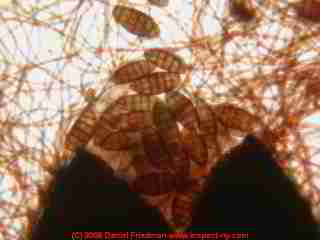
Ascospores: or Ascomycetes are ubiquitous spore with more than 3000 genera. Allergic reaction varies depending on genus and species; they have been poorly studied. Common indoor ascomycetes include Chaetomium and Ascotricha. -- EMLAB www.emlab.com
We (DF) find these spores individually in air samples indoors and outside, and we find them in dense profusion on occasion on decaying building surfaces.
Our remarkable photograph of an ascomycete shown here is Pleospora in the process of being born, collected from a wood post in a building basement by our associate Craig Balchunas and identified in our lab by the author D. Friedman.
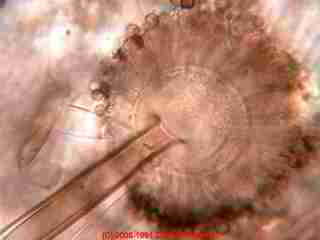
Aspergillus/Penicillium: [Common in indoor environments where moisture or flooding have occurred, where it is commonly found in carpet, wallpaper, and in interior fiberglass building or HVAC duct insulation--DF]
Also referred to as "Pen/Asp," this category is used to report spores when found without sufficient accompanying details or associated fungal material to distinguish reliably between the two genera, and where additional steps to further identify to genera and species (for example by culture) is not requested or not warranted.
Often the identification of these two species is combined as their spores are nearly impossible to differentiate by microscopy unless the underlying mold structure can also be found.
The Aspergillus genus contains over a hundred species of which 15 are commonly found in residential buildings.
Penicillium genus is similar. A wide number of organisms have placed in this genera. Identification to species is difficult and can require multiple cultures. Often found in aerosol samples.
This pair of genera is commonly found in soil, food, cellulose and grains. It is also found in paint and compost piles. It may cause hypersensitivity pneumonitis, allergic alveolitis in susceptible individuals. It is reported to be allergenic (skin). Some species can produce mycotoxins.
Common cause of extrinsic asthma (Immediate type, hypersensitivity: type I).
Acute symptoms include edema and bronchiospasms, chronic cases may develop pulmonary emphysema. Some are more toxic than industrial cancer-causing substances and are acutely toxic to the liver, brain, kidneys, and heart. Symptoms of acute aflatoxicosis are fever, vomiting, coma, and convulsions.
Symptoms that occur in most moderately contaminated buildings are not fully known but are expected to be less severe.
Toxicity, even within a particular strain, may vary depending on the particular growth conditions. My lab work often does not identify the sub-species of this genus so we do not know if very dangerous species are present in the building.
Most of these spores when found growing indoors are toxigenic or allergenic.
Given the risks of serious illness cleanup should be handled carefully and with expert advice. People with other illnesses or compromised immune systems (chemotherapy, bronchiectasis, carcinoma, or other mycoses) are at particular risk.
Any environment where this mold/fungus is found is a potential health hazard. -- U. Minn. and others. A. fumigatus may be low-count in air but high in localized areas. Diseases including Farmers Lung, invasive aspergillosis, and aspergiloma are linked to this mold. A. fumigatus and A. niger (which is shown in the photograph just above), appear to be allergenically distinct from A. versicolor, nodulus, and glaucus groups. -- labspec.co.za 8-01. See www.aspergillus.man.ac.uk The Aspergillus Website.
Aspergillus sp.: " - especially A. fumigatus, is one of the few genera of opportunistic pathogens consistently associated with disease.
Aspergillosis is the general term for the infection caused by any species of Aspergillus. Four leading types of Aspergillosis are colonization, allergy, disseminated infection, and toxicity. Pulmonary colonization and allergic reactions are induced by inhalation of large numbers of conidia."-Fundamentals of Diagnostic Mycology, Fisher & Cook. Reported to be allergenic.
Members of this genus are reported to cause ear infections [Mould Allergy, Yousef Al-Doory and Joanne F. Domson, Lea and Febiger, Philadelphia, 1984].
Many species produce mycotoxins which may be associated with disease in humans and other animals [ibid.].
Toxin production is dependent on the species or a strain within a species and on the food source for the fungus. Some of these toxins have been found to be carcinogenic in animal species.
Several toxins are considered potential human carcinogens [Dangerous Properties of Industrial Materials, 7th Edition, N.Irving Sax and Richard J. Lewis, Sr., Van Nostrand Reinhold, New York, New York, 1989.] Common cause of extrinsic asthma (immediate-type hypersensitivity: type I) [Manual of Medical Mycologyby John thorne Crissy, Heidi Lang, Lawrence Charles Parish, Blackwell Sciences, Cambridge, Massachusettes, 1995].
Acute symptoms include edema and bronchiospasms, chronic cases may develop pulmonary emphysema [Ibid.].
The Aspergillus genus contains over 170 species of which 15 are commonly found in residential buildings. A wide number of organisms have placed in this genera. While some species can be identified from field samples, identification to species is generally difficult even using culture methods.
PCR methods can speciate if data is already in the PCR database. Often found in aerosol samples. Commonly found in soil, food, cellulose and grains. It is also found in paint and compost piles.
Of the 170 16 species and one variety have been found to cause Aspergillosis, a respiratory illness in humans. It may cause hypersensitivity pneumonitis, allergic alveolitis in susceptible individuals. It is reported to be allergenic (skin). It is commonly found in carpet, wallpaper, and in interior fiberglass duct insulation. Some species can produce mycotoxins. Common cause of extrinsic asthma (type-type hypersensitivity: type I). Acute symptoms include edema and bronchiospasms, chronic cases may develop pulmonary emphysema.
Most of these spores are toxigenic or allergenic. Some are more toxic than industrial cancer-causing substances and are acutely toxic to the liver, brain, kidneys, and heart. Symptoms of acute aflatoxicosis are fever, vomiting, coma, and convulsions.
Symptoms that occur in most moderately contaminated buildings are not fully known but are expected to be less severe. Given the risks of serious illness cleanup should be handled carefully and with expert advice. People with other illnesses or compromised immune systems (chemotherapy, bronchiectasis, carcinoma, or other mycoses) are at particular risk.
Any environment where this [Aspergillus] mold/fungus is found [at contamination levels] is a potential health hazard. -- U. Minn., Fundamentals of Diagnostic Mycology, Fisher & Cook, Identifying Filamentous Fungi, St.Germain and Summerbell, and others.
A. fumigatus may be low-count in air but high in localized areas. Diseases including Farmers Lung, invasive aspergillosis, and aspergiloma are linked to this mold.
A. fumigatus and A. niger appear to be allergenically distinct from A. versicolor, nodulus, and glaucus groups. -- labspec.co.za 8-01. See www.Aspergillus.man.ac.uk The Aspergillus Website.
Aspergillus, a general opinion: texts and expert resources are not fully consistent in level of concern regarding the health risk of exposure to Aspergillus spores.
Depending the individual Aspergillus member species, on the size of the mold reservoir, the ease of spore movement from mold reservoir to occupied areas, the health and level of exposure of individuals being exposed, particular colony characteristics which may be influenced by the material and conditions on and under which the mold is growing, and variations in building conditions which can cause drastic changes in the amount of airborne spores in the environment, the level of risk to human health ranges from significant to insignificant.
It is prudent to be cautious and thorough in cleaning or removing this mold from building interiors and it would be particularly advised for people who are at-risk to avoid any exposure. -DF
Aspergillosis: "Although metabolites of species of Aspergillus (Hyphomycetes) cause other health problems, such as acute and chronic aflatoxin poisoning, we are concerned here only with diseases caused by the growth of the fungus itself somewhere in the body. Bronchopulmonary aspergillosis is usually caused by Aspergillus fumigatus, which colonizes mucus within the bronchi, evoking a severe allergic reaction.
In Aspergilloma, the fungus forms a mycelial ball in a lung cavity produced by an earlier attack of tuberculosis. The wall of the cavity may erode, causing the patient to spit blood, and necessitating surgical intervention.
Invasive aspergillosis is found only in patients who are severely debilitated, or are immunosuppressed, as in AIDS. The fungus grows outward from the lung, invading blood vessels and spreading to other organs through the bloodstream.
This insidious disease is usually fatal, and is often diagnosed only when an autopsy is performed." - The Fifth Kingdom, Chapter 23, Bryce Kendrick.
Aspergillus: specific species
Aspergillus candidus: "Associated with respiratory complaints in a recent house investigation. Can produce the toxin petulin which may be associated with disease in humans and other animals." - U. Minn.
Aspergillus carneus: occasionally pathogenic - U Minn.
Aspergillus clavatus: "Can produce the toxin petulin which may be associated with disease in humans and other animals. This species is only occasionally pathogenic." - U. Minn. DJF note: check for more severe opinions at other sources.
Aspergillus deflectus: occasionally pathogenic - U. Minn.
Aspergillus flavus: "Some strains are capable of producing a group of mycotoxins - in the aflatoxin group. Aflatoxins are known animal carcinogen. There is limited evidence to suggest that this toxin is a human carcinogen. The toxin is poisonous to humans by ingestion
. It may also resulting occupational disease via inhalation. Experiments have reported to be allergenic. Its presence is associated with reports of asthma. It can be found in water damaged carpets. The production of the fungal toxin is dependent on the growth conditions and on the substrate used as a food source.
This fungus is associated with Aspergillus of the lungs and or disseminated aspergillosis. This fungus is occasionally identified as the cause of corneal, otomycotic and nasoorbital infections." - U. Minn.
Aspergillus fumigatus: "Major cause of aspergillosis. Both invasive and allergic aspergillosis are caused by this organism. Aspergillosis affects individuals who are immune compromised. It is considered a human pathogen." - U. Minn. "This is the species of Aspergillus most frequently isolated from human patients." -- Fundamentals of Diagnostic Mycology, Fisher & Cook, p.47.
These authors continue with "A. fumigatus and other species are exogenous (literally, "generated outside" - not part of the normal flora), and are not infectious.
Typically people are at risk only when they are seriously debilitated or weakened as a result of another disease process ( - or treatment for some life-threatening illness). Injuries or infections that cause scarring of the lung tissue may predispose a person to an aspergillosis, especially an aspergiloma." - ibid. -- DF
Aspergillus glaucus: "Common outdoor fungus in winter. It is reported to be allergenic.
This species is only occasionally pathogenic. It can grow on leather. This fungus can grow at low moisture levels on grain, sugary food products, meat and wool." - U. Minn. "Pathogenicity: Only a few cases of pulmonary or disseminated infection have been reported from immunocompromised patients." -- Identifying Filamentous Fungi, St.Germain and Sumemrbell.
Aspergillus nidulans:"Can produce the mycotoxin sterigmatocystn. This toxin has been shown to produce liver and kidney damage in lab animals. This fungus is associated with aspergillosis of the lungs and or disseminated aspergillosis. This species is only occasionally pathogenic."
According to U. Minn. However de Hoog et als (Atlas of Clinical Fungi) report that "this species has been reported as an etiologic agent of diverse infections in humans and animals, either alone or in association with other opportunistic fungi, among them pulmonary infections, sinusitis, osteomyelitis, and superficial as well as disseminated infections." - © 2017 - 2010 DJ Friedman
Aspergillus niger: "Less common cause of aspergillosis. It has a musty odor. It is commonly found on textiles, in soils, grains, fruits, and vegetables. It has been reported to cause skin and pulmonary infections. It is a common cause of fungal related ear infections-otomycosis." - U. Minn.
Aspergillus ochraceus: "Found in grains, soil, and salted food products. It is not usually associated with decaying vegetation. Can produce a kidney toxin ochratoxin A which may produce ochratoxicosis in humans. This is also known as Balkan nephropathy.
The ochratoxin may also be produced by other Aspergillus sp. and Penicillium sp.
Other toxins which can be produced by this fungus include penicillin acid, xanthomegnin and viomellein. These are all reported to be kidney and liver toxins." - U. Minn.
Aspergillus oryzae: occasionally pathogenic. - U. Minn.
Aspergillus parasiticus: "Some strains are capable of producing a group of mycotoxins - in the aflatoxin group. Aflatoxins are known animal carcinogen. There is limited evidence to suggest that this toxin is a human carcinogen. The toxin is poisonous to humans by ingestion.
Experiments have indicated that it is teratogenic and mutagenic. It is toxic to the liver. The production of this fungal toxin is dependent on the growth conditions and on the substrate used as a food source." - U. Minn.
Aspergillus penicilloides: Conidia dimensions 3-3.5 x 4-5 microns [abbreviated further as "u" in this document]. C"Mould Allergy," Yousef Al-Doory and Joanne F. Domson, Lea and Febiger, Philadelphia, 1984.]
Aspergillus restrictus: This species is only occasionally pathogenic. - U. Minn.
Aspergillus sydowi: This species is only occasionally pathogenic. ["Manual of Medical Mycologyby," John thorne Crissy, Heidi Lang, Lawrence Charles Parish, Blackwell Sciences, Cambridge, Massachusettes, 1995.]
Aspergillus terreus: Conidia dimensions 1.8-2.4u / 2 - 2.5u. Aleurospores 6 - 7u in diameter are also produced. Found in warmer soil and in grains, straw. cotton and decomposing vegetation Can produce the toxin patulin and citrinin which may be associated with disease in humans and other animals.
This fungus is associated with aspergillosis of the lungs and or disseminated aspergillosis.
Found as an isolate from otomycosis - ear infection and onychomycosis - infection of finger or toe nails.[Op.cit.Mould Allergy & Manual of Medical Mycology]. --U. Minn.
Aspergillus ustus: This species is only occasionally pathogenic [Op. Cit. Manual of Medical Mycology]. - U. Minn.
Aspergillus versicolor: Conidia dimensions 2-3.5u It is commonly found in soil, hay. cotton and dairy products, It can produce a mycotoxin sterigmatocystin and cyclopiaxonic acid. These toxins can cause diarrhea and upset stomach. It is reported to be a kidney and liver carcinogen.
This species is only occasionally pathogenic. [Op.cit.Mould Allergy][Op. Cit. Manual of Medical Mycology] - U. Minn.
OBS - Aspergillus sp.: Reported to be allergenic [Burge, H.A. 1985. "Fungus allergens," Clin. Rev. Allergy , 3:19-329]. Members of this genus are reported to cause ear infections. Many species produce mycotoxins which may be associated with disease in humans and other animals. Toxin production is dependent on the species or a strain within a species and on the food source for the fungus.
Some of these toxins have been found to be carcinogenic in animal species. Several toxins are considered potential human carcinogens [Dangerous Properties of Industrial Materials, 7th Edition, N.Irving Sax and Richard J. Lewis, Sr., Van Nostrand Reinhold, New York, New York, 1989]
Common cause of extrinsic asthma (immediate-type hypersensitivity: type I). Acute symptoms include edema and bronchiospasms, chronic cases may develop pulmonary emphysema [Op.cit.Mould Allergy] [Op. Cit. Manual of Medical Mycology] - U. Minn.
Aspergillus sydowi: This species is only occasionally pathogenic [Op. Cit. Manual of Medical Mycology].
Aspergillus terreus: Conidia dimensions 1.8-2.4u to 2 - 2.5u. Aleurospores 6 - 7u in diameter are also produced. Found in warmer soil and in grains, straw. cotton and decomposing vegetation. Can produce the toxin patulin and citrinin which may be associated with disease in humans and other animals. This fungus is associated with aspergillosis of the lungs and or disseminated aspergillosis. Found as an isolate from otomycosis - ear infection and onychomycosis - infection of finger or toe nails [Op.cit.Mould Allergy][Op. Cit. Manual of Medical Mycology] - U. Minn.
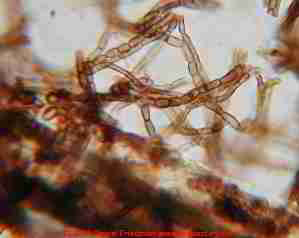
Aureobasidium: typically Aureobasidium pullulans, this is a common species found in leaves, soil, wood materials, paper, leather, cotton, and on paint, plastic, concrete, and some optical lenses.
It is common on bathroom walls and shower curtains, often perceived as "mildew," and it also is found outdoors on siding. "This yeast-like fungus is commonly found on caulk or damp window frames in bathrooms. A
ureobasidium may be pink or black in color.
Although Aureobasidium mold exposure seldom causes infections, it can be allergenic. This is one type of mold that is a type of mildew [That comment is almost certainly incorrect: Aureobasidium is not a mildew, since per Haines mildew is an obligate parasite growing only on living plants - DF].
It will grow in cooler climates and along with Cladosporium is commonly found growing on siding." -- Cit: restcon.com/links/articles/mold_and_mildew.html -- Aureobasidium sp. is typically fast-growing black, brown, cream, or pink colonies, one of several genera of "black yeasts."
Common world-wide, usually found as a saprophyte (causing wood decay), and occasionally from skin and nails. Clinical group: opportunistic mycosis; Mycosis: Phaeohyphomycosis; -- Ref: Mycology online, Malloch Lab (U. Toronto), and fungus web at U.Texas. - in buildings unlikely to be a human pathogen, may be allergenic
"Black mold" in attics when found as discoloration on the under-side of roof sheathing, particularly plywood roof sheathing, is frequently Aureobasidium pullulans as shown in the photograph here. In this photgraph of Aureobasidium pullulans in a tape sample lifted from an area of black-stained plywood roof sheathing where no obviously moldy material was visible to the naked eye (just discolored black plywood roof decking), this fungus was growing on and in wood fibers pulled from the plywood roof decking by our tape sample.
This is typical of the black discoloration seen on roof sheathing in attics where there has been excessive moisture on those surfaces such as from roof leaks or due to condensation in an inadequately-vented attic. While we find this fungus on wood building surfaces we do not usually find it at any significant level in indoor air--Opinion: DF.
B
Bacteria-like material in indoor air or dust particle samples:
Bacteria-like material or Bacteria-covered skin scales, fibers, or mite fecals should be taken as a tip to look for and reduce sources of water entry or moisture.
If the sample appears to contain significant levels of bacteria you should also be looking for a possible source such as a sewage backup or burst drain piping which could have left pathogens in the building. Airborne skin scales may carry pathogens such as bacteria which, on occasion, can be visible as sub-micron structures on individual scale particles.
High levels of bacteria (not fully determined by microscopic examination) could indicate other biological contamination and health risks including pathogenic hazards such as harmful bacteria or viruses.
Where this evidence is present, where there is a history of sewage leaks or backup in a building, or where building-related illness is suspected and we have not found obvious mold or allergens, additional testing for bacteriological or viral hazards should be considered.
Other possible sources of bacterial or viral pathogens include aerosolized droplets from a humidifier or air conditioner, and soil dust, for example from a basement or crawl space where there has been a sewage spill or where animal fecal waste has been deposited.
[Although bacteria may be visible in environmental particle samples, (and will be reported here) bacteria and viruses are beyond the scope of my inspection and are not my expertise.]-DF
Also see:SEWAGE CONTAMINATION in BUILDINGS -DF
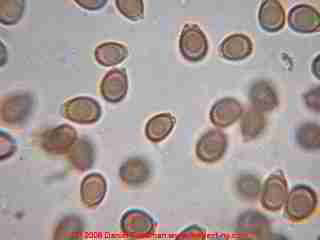
Basidiomycetes- Fungal spores which are from mushrooms. The specific mushroom species cannot be identified on the culture plate. Many mushroom spores are reported to be allergenic. -- U. Minn."
Frequently associated with dry rot, Basidiomycetes are primarily mushrooms, toadstools, puffballs, rusts and smuts. High levels of these spores can contribute to allergies in indoor environments.
Poria incrassata (Meruliporia incrassata) is a particularly destructive fungal organism that falls into this classification. "Poria"has resulted in the collapse of severely infested buildings." -- Cit: .restcon.com/links/articles/mold_and_mildew.html
When basidiomycete mold spores are found indoors in quantity I recommend additional inspection to identify the source of this mold and extent of its presence as it's likely to be found in areas of wet conditions where there is risk of rot or other structural damage.
See MERULIPORIA HOUSE EATING FUNGUS for more information about house eating fungi.
Our mold photograph shown here is of Ganoderma applanatum collected by the author during a building inspection.
When this spore is being released it is ubiquitous in air samples and we almost always find at least a few of these spores in indoor and outdoor air and often in settled dust indoors or outside.
 Another important interpretation of high levels of indoor Basidiomycetes might be the indication of wet
conditions and wood-rot as an indicator of a higher risk of presence of other health-complaint problematic molds such as
Aspergillus/Penicillium spores or Stachybotrys chartarum spores
Another important interpretation of high levels of indoor Basidiomycetes might be the indication of wet
conditions and wood-rot as an indicator of a higher risk of presence of other health-complaint problematic molds such as
Aspergillus/Penicillium spores or Stachybotrys chartarum spores
- three groups of molds which are common in wet buildings and which are often associated with IAQ and health complaints.- DJF
Beauvaria sp.: often,B. bassiana. This is a cosmopolitan soil fungus, also isolated from parasitised insects (muscardine disease of the silkworm).
Beauvaria is rarely responsible for infection in humans or animals, causing rare cases of keratitis, and one case of Pneumonia has been reported in an immunocompromised patient. -Identifying Filamentous Fungi, St-Germain and Summerbell.
Elsewhere this fungus is described as a "virulent insect pathogen," with confirmation that infections in humans are rare.
The pulmonary infection reported by Freour (1966) was probably Acrodontium sp.
A pulmonary infection has also been reported in a captive American alligator and in a tortoise. - Atlas of Clinical Fungi, deHoog et als. Sources paraphrased by DJ Friedman.
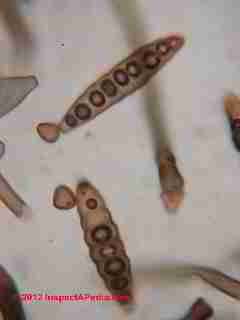 Biological Pollutants in the Home - general guidance from the US EPA
Biological Pollutants in the Home - general guidance from the US EPA
- BIOLOGICAL POLLUTANTS in the HOME - EPA
Bipolaris sp. -(photo at left) A fungus with large spores which would be expected to be deposited in the upper respiratory tract.
Bipolaris fungus can produce the mycotoxin - sterigmatocystin which has been shown to produce liver and kidney damage when ingested by laboratory animals. U. Minn.
Bispora sp. - No medical information at hand. In absence of data it is reasonable to expect fungal spores to be allergenic if present indoors at high levels.
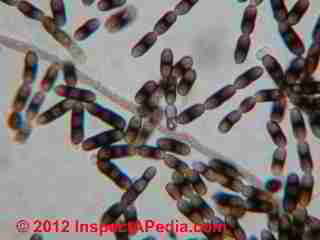 Bispora is a widespread fungus found in temperate climates.
Bispora is a widespread fungus found in temperate climates.
Bispora betulina is found in buildings on wood in wet areas. It can cause soft-rot wood decay.
- Identification Manual for Fungi from Utility Poles in the Eastern United States, CJK Wang and RA Zabel, 1990; The Atlas of Clinical Fungi, 2nd Ed., deHoog et als, 2000, does not cite this genus as associated with known illnesses (p. 1016).
Blastomyces sp. - Human pathogen. The fungus is commonly found in soil. It is a dimorphic fungus which has filamentous fungus when grown at 25 degrees C and a yeast form at 37 degrees C. -- U. Minn.
Botrytis sp.- Reported to be allergenic. It is parasitic on plants and soft fruits. Found in soil and vegetables. Possibly associated with allergic symptoms (skin tests). U. Minn. Cf labspec.co.za also.
Associated with
plants, can cause allergic asthma. www.restcon.com/links/articles/mold_and_mildew.html
C
Candida sp.: "...Part of the normal flora of mouth and other mucous membranes in the body.
Thrush and other diseases caused by Candida albicans usually occur after prolonged treatment with antibiotics or steroids. The environment is not a likely source of exposure for this fungus.
Cells from the candida organism are usually not airborne [Atlas of Moulds in Europe causing respiratory Allergy, Foundation for Allergy Research in Europe, Knud Wilken-Jensen and Suzanne Gravesen, Eds. ASK Publishing, Denmark, 1984.]. Reported to be allergenic [Op. Cit. Burge, H.A. 1985. "Fungus allergens,"]." - U. Minn.
Capronia sp.(Ascomycete) - teleomorph (sexual stage) of Cladophialophora - Atlas of Clinical Fungi - DeHoog et als. See Cladophialophora.
Cellulose and plant fragments: most likely due to open windows and outside leaf blowing and mulching, likely to be a temporary spike in occurrence. Other plant fragments and plant trichomes found in some of my samples are very common indoors and do not indicate a problem in most cases.
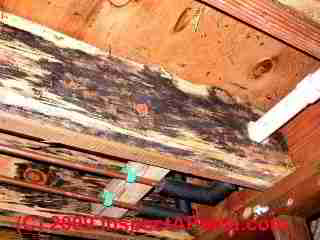 Ceratocystis/Ophistoma sp. - C. piliferumand C. virescens are common dark
molds found on the surface of framing lumber in construction. Gonatobotryum is a mycoparasitic mold (a fungus
parasitizing another fungus) that is often found growing on C/O group. The C/O group is not reported to infect humans or
animals.
Ceratocystis/Ophistoma sp. - C. piliferumand C. virescens are common dark
molds found on the surface of framing lumber in construction. Gonatobotryum is a mycoparasitic mold (a fungus
parasitizing another fungus) that is often found growing on C/O group. The C/O group is not reported to infect humans or
animals.
Details about this fungus are
at BLACK MOLD, HARMLESS COSMETIC
A connection between Ophiostoma and the human pathogen Sporothrix schenckii has been proposed but not confirmed. The C/O group is probably present in a very large number, arguably a majority, of wood framed buildings.
It could therefore be inferred that the health risks are very low and the issue for this group of fungi is largely cosmetic-paraphrased by DF from EMLab's Pyam Fallah 6/04.
The presence of this species inside a building on framing lumber is called "blue stain" or "sap stain" and is cosmetic - Haines & Gallup 10/01 to DF; Ceratocystis fimbriata is a plant pathogen causing blue rot, Dutch elm disease, oak wilt and cacao wilt. - Iowa State University.
Also, see Ophistoma sp. Ceratocystis fimbriata fungal contamination in sweet potato leads to the production of ipomeamarone, a hepatoxin, while other metabolites like 4-ipomeanol are pulmonary toxins.
Baking destroys only 40 percent of these toxins. Catalano et al. (1977) reported that peeling blemished or diseased sweet potatoes from 3 to 10 mm beyond the infested area is sufficient to remove most of the toxin. See Ceratocystis and Ophistoma, Taxonomy, Ecology, and Pathogenicity, Wingfield, Siefert, and Webber, Ed., APS press, 1993.
Cerebella sp. - -- no medical information was located, i.e. this fungus is not cited in common clinical fungi references which concern fungal species which are pathogens.
Where this mold has been found observers should be alert for other fungal species as mold-conducive conditions are present. This fungus may be a wood-rotter.-- DJF
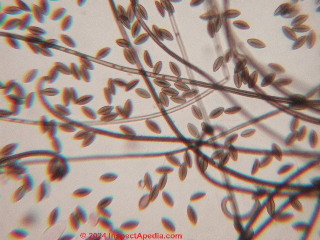 Chaetomiumsp. Large ascomycetous fungus producing perithecia. It is found on a variety of
substrates containing cellulose including paper and plant compost. It has been found on paper in sheetrock.
Chaetomiumsp. Large ascomycetous fungus producing perithecia. It is found on a variety of
substrates containing cellulose including paper and plant compost. It has been found on paper in sheetrock.
Chaetomium is reported to be allergenic. -- U. Minn. Commonly found indoors are C. globosum and C. funicola.-DJF.
Associated with a "musty odor" indoors, and while not well studied, some rare compounds may be reported as mutagenic.
Where this mold is found indoors, you should consider it a water/wet condition indicator, which means that other problematic molds may be present - further investigation may be appropriate.
Chaetomium is a common cause of soft-rot in buildings - look for structural damage -- DJF
Chains of mold Spores such as Pen/Asp, in chains:The presence of mold spores in chains suggests that there is some active mold growth in this building.
These chains are so fragile that if mold were only entering from outdoors it is more likely that I would only see single spores or very small fragments.
Chlamydospores: are thick-walled resistant spores which develop to permit a fungal species to survive in a dormant state, typically waiting for more favorable conditions for growth.
They are an indication of conditions previously favorable to fungal growth, and can produce future fungal activity. -- Illustrated Dictionary of Mycology, Ulloa & Hanlin, American Phytopathological Society, 2002.
Chrysosporium: This is a common fungus found on dead organic material (saprobe). occasional reports of skin and nail infections are questioned by Germain/Summerbell.
One species has been (rarely) substantiated as an agent of onchomycosis -- Identifying Filamentous Fungi, Germain and Summerbell; " - isolated as a rare cause of hyalohyphomycosis, endocarditis, osteomyelitis, and adiaspiromycosis - (enlargement of conidia in tissue without replication, at high temperature)" - Fundamentals of Diagnostic Mycology, Fisher, Cook; both sources paraphrased/quoted by Daniel Friedman.
Cladophialophora sp. -velvety to powdery to woolly gray-green to olive green to black (front) and black (reverse) colonies (in culture), absent or inconspicuous conidiophores. Hyphae are septate, brown.
Conidia: one-celled dry spores arising in long, poorly-branched, often coherent chains, conidial scars nearly unpigmented, or per Dr. Fungus, no attachment scares are visible. Conidia are smooth, (or occasionally echinulate or mixed C. bantiana), lemon-shaped (C. bantiana, C. carrionii) or round (C. boppi). Pathogenic to humans.
Each Cladophialophora species provokes a mycosis characteristic for that species. C. bantiana causes cerebral phaeohyphomycosis in humans and is usually fatal. The fungus is probably introduced by inhalation; it is opportunistic in immune-compromised patients.
Tolerant to cycloheximide, intolerant to benomyl. C. boppi & C. carrionii are a relatively common cause of chromoblastomycosis, localized skin and subcutaneous lesions leading to superficial, warty, cauliflower-like tumors when introduced by cutaneous injury - trauma and exposure to soil are main predisposing factor for this species.
C. boppi may also cause skin lesions. C. devriesii has been reported to cause disseminated phaeohyphomycosis. - doctorfungus.org & Atlas of Clinical Fungi - DeHoog et als. -
Any building where this mold family is present or even might be present should be treated with extreme caution and professional inspection, remediation, and if appropriate, medical advice obtained promptly-opinion of DJF.
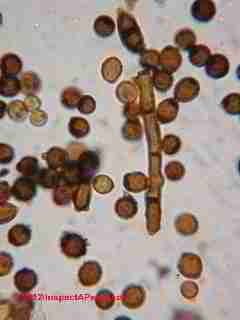 Cladosporium sp. (Hormodendrum sp.). [Most commonly identified outdoor fungus, and
existing in a great many varieties (possibly 50).-DF] The outdoor numbers are reduced in the winter.
Cladosporium sp. (Hormodendrum sp.). [Most commonly identified outdoor fungus, and
existing in a great many varieties (possibly 50).-DF] The outdoor numbers are reduced in the winter.
The numbers are often high in the summer. Often found indoors in numbers less than outdoor numbers.
It is a common allergen. Indoor Cladosporium sp. may be different (C. sphaerospermum) than the species most often identified outdoors (C. herbarum, C.sporoioides C. acaciicola) but the outdoor species often accompany indoor brethren in samples.
Cladosporium sphaerospermum (photo at left) and some other C. sp. species is commonly found on the surface of fiberglass duct liner in the interior of supply ducts. We also find this mold growing on painted block walls in basements and crawl spaces.
Cladosporium sphaerospermum (and some other species of Cladosporium) can cause mycosis.
Produces greater than 10 antigens. Common cause of extrinsic asthma (Immediate type, Hypersensitivity: type I).
Acute symptoms include edema and bronchiospasms, chronic cases may develop pulmonary emphysema . -- U. Minn. -- labspec.co.za - allergenic; additional editing of U. Minn text by DJF.
Cladosporium fulvum (Fulvia fulva): "Conidia dimensions 12-47 x 4-10u. It is found on the leaves of tomatoes" [Op.Cit. Mould Allergy , Yousef Al-Doory et als.]. - U. Minn.
Cladosporium herbarum: Conidia dimensions 5-23 x 3-8u. It is found on dead plants, woody plants, food, straw, soil, paint and textiles [Op.Cit. Mould Allergy , Yousef Al-Doory et als.] - U. Minn.
Cladosporium macrocarpum: Conidia dimensions 9-29 x 5-13u. It is found on dead plants, woody plants, food, straw, soil, paint and textiles [Op.Cit. Mould Allergy , Yousef Al-Doory et als.] - U. Minn.
Cladosporium sphaerospermum: Conidia dimensions 3-4.5u. It is found as a secondary invader of plants, food, soil, paint and textiles [Op.Cit. Mould Allergy , Yousef Al-Doory et als.] - U. Minn. This spore is often found indoors in buildings and by my field experience much less often in outdoor air samples. - DJF.
Clay: used in ceramics, many ingredients such as additives and glazes may pose particular respiratory health hazards.
Some articles addressing a few of these concerns are at http://www.claytimes.com/index_S.htm
In addition to asbestosis, cobalt or cadmium poisoning, kaolinosis, lead poisoning, silicosis,
"Hypersensitivity pneumonia, asthma, or other respiratory problems may occur with exposure to molds growing in wet clay that is being soured or aged in a damp place, in slips that stand for months, or with inhalation of dry aged clay. Molds can cause or exacerbate skin problems and change the workability of clay." -- Princeton University's Art Safety Guide.
This resource provides a good summary of hazards from clay and its common constituents. Guide: http://web.princeton.edu/sites/ehs/artsafety/sec12.htm. Also see http://www.goshen.edu/art/DeptPgs/Hazards.html "Hazards in Ceramics".
Kilns in basements present particular hazards (of hazardous condensates) if they are not expertly and reliably vented. Also see Clay, Talk, Nephaline syenite, Cornwall Stone.
Cornwall stone: repeated exposure risks silicosis. http://www.lagunaclay.com/msds/2glaze/GR19.pdf Also see Clay, Talk, Nephaline syenite, Cornwall Stone.
Cryptococcus sp. Cryptococcus neoformans, a blastomycete, is widespread and is particularly likely to be found where pigeons (or other birds) have roosted. It has been found in dairy products, fruits, and vegetables.
With a typical size of 2u, these spores can be inhaled deeply into the lung alveoli where they establish colonies and can cause disease. It is an opportunistic pathogen which can cause meningitis (life-threatening meningoencephalitis) in immunocompromised patients.
"Exposure to soil contaminated with pigeon excrement (and possibly Cryptococcus) is particularly hazardous to those who are immunosuppressed." Quoted and paraprased from Fundamentals of Diagnostic Mycology, Fisher & Cook -- DJF.
The fungus, Cryptococcus neoformans, "has two sexes, alpha and a, but the vast majority of C. neoformans isolates seen clinically and in the environment are alpha, leaving them with apparently few chances to mate.
It turns out, though, that the alpha C. neoformans go through a process known as "fruiting," which researchers thought was asexual" but apparently isn't after all. - paraphrased from Science magazine quoting Nature magazine, 2005.
[LAB NOTE: Prepare suspect samples in India ink and look for the characteristic white circles against the black background -see Fisher Cook 7.16 p. 213. ]
 Cockroach allergens: the principal sources of cockroach allergen are roach body parts, egg casings, and
digestive secretions.
Cockroach allergens: the principal sources of cockroach allergen are roach body parts, egg casings, and
digestive secretions.
These cockroach allergens, typically larger than the most problematic mold spores, tend to settle quickly from the air but will remain on building surfaces for a long while, even tough the cockroach population may have been exterminated.
Our photo (left) illustrates fragments of cockroach insects that are also found in house dust along with the other parts listed above - in this case cockroach mouth and jaw parts.
Such allergens are easily disturbed and made airborne by activities in the living area, and therefore can be inhaled, creating a particular risk for asthmatics, children, the elderly, and others who may be at special risk. Reference: There are numerous studies and citations supporting this subject.
A starting point in MEDLINE which will provide links into this data is this article:
The role of cockroach allergy and exposure to cockroach allergen in causing morbidity among inner-city children with asthma, N Engle J Med. 1997 May 8;336(19):1356-63. PMID: 9134876 [Plumbed - indexed for MEDLINE] http://www.ncbi.nlm.nih.gov/entrez/query.fcgi?cmd=retrieve&db=pubmed&list_uids=9134876&dopt=medline --DF 11/03
Some cockroach control and asthma-related resources include:
New York State Integrated Pest Management
Program: http://www.nysipm.cornell.edu/psa/
University of
Nebraska, Cockroach Control: http://pested.unl.edu/cocktoc.htm
Environmental Health Watch Cockroach Control Guide: http://www.ehw.org/Asthma/ASTH_Cockroach_Control.htm
Univ. of Calif. Statewide Integrated Pest management Program: http://www.ipm.ucdavis.edu/PMG/PESTNOTES/pn7467.html
Control of Factors Contributing to Asthma Severity: http://www.vh.org/adult/provider/internalmedicine/AsthmaIM/comp2/Control.html
Alliance for Healthy Homes, guidance on cockroaches: http://www.afhh.org/dah/dah_cockroaches.htm
Conidiobolus: "fungi of the order Entomophthorales which can cause a type of chronic zygomycosis presenting initially as an infection of the nasal mucus membranes. Recently, some cases of disseminated infection in the immunocompromised host have been reported." - Identifying Filamentous Fungi, St-Germain & Summerbell 1996, p100.
An agent of nasal granuloma in man, can lead to nasal obstruction.
Found particularly in outdoor workers in tropical
rainforests of
Conidiophore: the component of a fungus which produces fungal spores.
A conidiogenous cell, or a fertile fungal cell which is specialized for the production of conidia (fungal spores). [paraphrased] - Illustrated Dictionary of Mycology, Ulloa and Hanlin.
Conidobolus sp.: Can cause a chronic inflammatory disease of the nasal mucosa (entomophthoromycosis) [Medically Important Fungi - A Guide to Identification, 2nd edition, Davise H. Larone, American Society for Microbiology, Washington, D.C. 1995.] - U. Minn.
Cryptostroma corticale: Conidia dimensions 4-6.5 x 3.5-4u. Found on the bark of maple and sycamore trees and on stored logs [Op.Cit. Mould Allergy , Yousef Al-Doory et als.] - U. Minn.
Cunninghamella sp.: Can cause disseminated and pulmonary infections in immune compromised hosts [Op.Cit. Medically Important Fungi - A Guide to Identification] . - U. Minn.
Curvularia sp. - Curvularia sp. - Allergen, Irritant, Hypersensitivity pneumonitis, Dermatitis--OSHA; Phaeohyphomycosis including sinusitis, endocarditis, peritonitis and disseminated infection--Univ. Adelaide, Australia; Allergenic; may cause corneal infections, mycetoma, and infections in immune compromised hosts. U. Minn.;
Phaeohyphomycosis - a group of mycotic infections which take the form of local abscesses - Univ. of Texas; Curvularia is mainly an opportunistic leaf spot fungus and a weak pathogen that survives mostly as a saprophyte.
It is easily isolated from dead turf (thatch) and other weakened and dead plant tissue. It causes leaf spots on grasses as well as storage molds of grains. Georgia College of Agriculture & Environmental Science, Cooperative Extension, Dept. of Plant Pathology.
http://fungusweb.utmb.edu/mycology/phaeohyphomycosis.html
http://www.ces.uga.edu/Agriculture/plantpath/epphomep.html
http://www.osha-slc.gov/dts/chemicalsampling/data/CH_230250.html
"In the last half century, this species has emerged as a human pathogen, although such diseases are extremely rare outside of the tropics. Due to its relatively large size, the spore remains in the nose or sinus after inhalation. Rarely, a chronic, allergic sinusitis may be provoked in patients with existing allergic rhinitis (hay fever). A Serine protease has been identified as a major allergen of C. lunata.
A potent mycotoxin curvularin has been isolated from C. lunata, a rice contaminating species.
Experimental mycotoxicosis were produced in albino rats. Another toxin, curvularol, from Curvularia sp., RK 97-F166 (Nagasaki, Japan) inhibited cell cycle progression of normal rat kidney cells in G1 phase at 150ng/ml.
These effects have not been observed in people, and exposure to sufficient toxin to cause illness is extremely unlikely." - "Fungus of the month: Curvularia species," Srivandana Kilambi, Environmental Reporter, April 2005.
D
Dactylosporium sp. - no information on pathogenicity or allergenicity
Daldrinia sp. - Very common basidiospores, no medical data.
Debris at excessive levels: this comment means that the sample contained excessive levels of particle debris. When a sample collects to much debris important particles may be obscured in the debris. If it was an air or vacuum sample, high levels of debris can also cause important particles, particularly small spores such as Penicillium sp. or Aspergillus sp. to fail to adhere to the collection media.
Both of these factors tend to make any estimate of the levels of spores or problem particles lower than actual in samples containing excessive levels of debris.
Dicyma sp. - No information found about health effects or toxicity.
Allergenicity and toxicity have apparently not been studied.
Dicyma olivacea is found on building surfaces by tape lifts [J. Haines, NY State Museum and DJF personal experience], but it will not generally appear in cultured samples using typically-selected culture media.
In the absence of medical research it may be prudent to consider large areas of fungal contamination as potentially allergenic and as a respiratory irritant. Ref: Farr, D.F., Rossman, A.Y., Palm, M.E., & McCray, E.B. (n.d.) Fungal Databases, Systematic Botany & Mycology Laboratory, ARS, USDA also Ellis, M.B. (D.H.) and EMLAB. Retrieved April 25, 2003-DJF.
Drechslera, Bipolaris, and Exserohilium (group commonly identified together and not speciated) - some species produce mycotoxins which affect the liver. Also associated with eye infections, sinus infections, asthma, and hay fever.-- Aerobiology Research Labs
Dicyma sp. - No information found about health effects or toxicity.
Allergenicity and toxicity have apparently not been studied. Dicyma olivacea is found on building surfaces by tape lifts [J. Haines, NY State Museum and DJF personal experience], but it will not generally appear in cultured samples using typically-selected culture media.
In the absence of medical research it may be prudent to consider large areas of fungal contamination as potentially allergenic and as a respiratory irritant. Ref: Farr, D.F., Rossman, A.Y., Palm, M.E., & McCray, E.B. (n.d.) Fungal Databases, Systematic Botany & Mycology Laboratory, ARS, USDA also Ellis, M.B. (D.H.) and EMLAB. Retrieved April 25, 2003-DJF.
Diplococcium sp. - this fungus is an anamorph of Helminthosphaeria - Dictionary of the Fungi, 9th ed.; we have not found reference to it in clinical or medical references such as Fundamentals of Diagnostic Mycology, Fisher/Cook, or Atlas of Clinical Fungi, 2nd ed., deHoog et als.
Found on dead, often rotting wood and bark of various tree [species]. - Dematiaceous Hyphomycetes, M.B. Ellis.
If found in a building sample it should be considered a water/moisture indicator which in turn should be considered an alert for possible presence of other, problematic fungi - DJ Friedman.
Diplosporium flavum - This is a saprophytic fungus which I have found occasionally in indoor samples on drywall.
No information was found about health effects or toxicity. Allergenicity and toxicity have apparently not been studied. In the absence of medical research it may be prudent to consider large areas of fungal contamination as potentially allergenic and as a respiratory irritant.-DJF
Doratomyces sp. - common in soil, dung, and decaying plant materials. Medical information - not at hand.
Dust and House Dust in buildings - see "Sub-micron particulates" and "World Trade Center Dust" below
E
Efflorescence is a mineral salt, usually whitish and crystalline in appearance, left behind when water evaporates; it is commonly found on masonry surfaces where there has been water leakage. While this material is not a fungal spore, its presence indicates a history of high moisture in the area where it could be collected. In turn, high moisture is a key component in the presence of unwanted fungal spore growth as well as other possible building problems. - DJ Friedman.
Some of us misspell efflorescence as "efflorescence" - this misspelling is here to help search engines find the right word: efflorescence or efflorescence salts on buildings. Please see Efflorescence & white or brown deposits for detailed information.
Emmonsia parva (=Chrysosporium parvum): " - is the etiolotic agent of adiaspiromycosis, a usually asymptomatic pulmonary infection encountered in animals and more rarely in humans.
The disseminated form of the infection is rarely seen in the immunocompromised host. E. parva var. crescens is the only type isolated from humans, while E. parva var. parva is often isolated from animals."
[paraphrasing and quoting:] Chrysosporium has produced occasional, questionable, reports of skin and nail infections, and one species has been substantiated on rare occasions as an agent of onchomycosis. - Identifying Filamentous Fungi, A Clinical Laboratory Handbook, Guy St. Germain, Richard Summerbell 1996.
Also see Atlas of Clinical Fungi, deHoog et als. P. 635 which adds that this fungus occurs in rodent burrows (soils), and adds that [on inhalation] "The adiaspore remains localized and does not reproduce, causing no or only a mild disease." Among rodents the percentage of animals is "remarkably high" according to my op.cit. --DJF
Emericella sp. - this is a teleomorph (sexual state) of Aspergillus. Emericella is found frequently in air and dust samples. Because Emericella is widespread and often found at low levels in indoor and outdoor air, I do not consider incidental occurrences of it in IAQ samples as indicative of a problematic level of mold indoors.
Teleomorph: the sexual (perfect) state of a fungus (ascomycete or basidiomycete) whose spores are produced by meiosis. - Illus. Dictionary of Mycology, Ulloa and Hanlin.
Epicoccum sp. - a secondary decomposer of plants, soil, paper, etc., common on dying substrates, cereals, plants, compost, human skin, sputum; more likely to be in air in calm dry weather; appears to be allergenic. -- labspec.co.za and can grow at higher temperatures than some other molds.
Exophiala sp. - "E. jeanselmei is the principal species of medical importance. [= Phialophora heteromorpha per deHoog et als.] occasionally a cause of mycetomas and of other subcutaneous phaeohyphomycoses. Exophiala werneckii is the etiologic agent of a superficial inspection known as tinea nigra.
Exophiala infections have also been reported from animals, especially fish." Identifying Filamentous Fungi, a Clinical Laboratory Handbook, Guy St-Germain, Richard Summerbell.
F
Feather barbules: if present in quantity may be allergenic; depending on the source (down quilts versus pigeons or pet birds) presence of this material could indicate other biological contamination and health risks including bacteriological hazards. (DF)
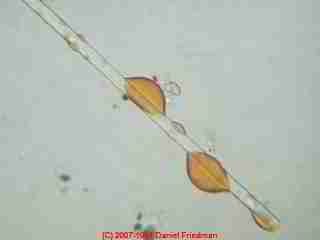 Fiberglass insulation fragments are inorganic material typically from fiberglass building insulation or duct
work.
Fiberglass insulation fragments are inorganic material typically from fiberglass building insulation or duct
work.
Depending on their size and quantity these may be a respiratory irritant or may contribute to more serious health concerns.
The presence of incidental fibers in buildings is common. The Association of Man-made Mineral Fiber Producers asserted to the US EPA in 1992 that a study at that time " - does not provide evidence of significant adverse health effects following inhalation of glass fiber."
("Respirable Fibrous Glass Chronic Multidose Inhalation Study-Preliminary Final Results," TIMA, 4 May 1992 delivered to U.S. EPA by hand.)
The Seventh Annual Report on Carcinogens (June 1994) lists glass fibers of respirable size as a substance "reasonably anticipated to cause cancer in humans."
DJF-note: in my opinion a there is a growing level of concern regarding these fibers; I suspect that they constitute a serious health risk.
Here are some additional references which address this concern:
http://www.osha.gov/media/oshnews/may99/trade-19990518.html OSHA release on worker protection;
http://www.aiha.org/abs01/01iaq1.html papers on fiberglass duct
research
http://www.hhinst.com/Artfiberglass.html John Bower's
article on fiberglass (Healthy House Institute)
http://www.epa.gov/appcdwww/iemb/biocontam.htm U.S. EPA
project on evaluation of fungal growth on fiberglass duct
http://www.sustainableenterprises.com/fin/basic.htm fiberglass information network
http://www.sustainableenterprises.com/fin/Victims/brown.htm
http://www.sustainableenterprises.com/fin/Victims/brown.htm litigation involving fiberglass duct
http://consumerlawpage.com/article/fiber.shtml published by a personal injury law firm;
http://eces.org/articles/static/80198280073119.shtml fiberglass as a more potent carcinogen than asbestos;
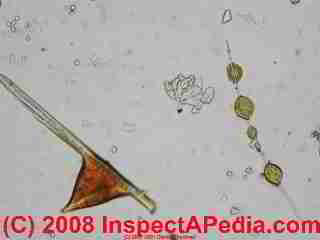 http://www.lungusa.org/diseases/fiberglass01.html safety of
fiberglass insulation;
http://www.lungusa.org/diseases/fiberglass01.html safety of
fiberglass insulation;
Fiberglass fragments in air: frequent presence of fiberglass fragments in air and some dust samples, suggesting that the duct system may be contributing unwanted and potentially unsafe levels of these fibers.
While the fiberglass industry does not agree that this is a hazard, independent studies and warnings at US government health-related websites suggest that there may be carcinogenic or respiratory health hazards from exposure to high levels of fiberglass particles.
If we find frequent presence of fiberglass fibers in air or interior dust samples further investigation, cleaning, and particularly investigation of air handling equipment and duct systems in the building would be appropriate.
If fiberglass HVAC duct work has been installed I very often find significant fiberglass levels in interior air and dust samples.
Because these materials cannot be mechanically cleaned and because I do not recommend encapsulant sprays, replacement could be in order. I would not expect movement of significant levels of fiberglass fragments from insulated attics, walls, ceilings into living areas under normal conditions.
Additional in-depth information on fiberglass hazards in buildings can be found at FIBERGLASS HAZARDS [website] - opinion DJF.
Fuglio septica mold growth: The Fuligo septica mold spores in our photo provide very different information than what we can get by eye looking at a mold culture plate or petri dish.
By eye when found growing on the ground, often on mulch around trees and shrubs, this fungus is popular called "dog vomit mold" because the yellow splash of fungus indeed looks a lot as if a dog has just vomited in that location.
Fungicide: A non-sealing clear fungicide was sprayed in areas of the --- according to the --- [mold remediation report excerpt] .
This may temporarily retard mold re-growth but does not protect longer term against mold nor against moisture uptake in these materials
It also does not serve to immobilize particles which may have been left behind after surface cleaning.
Fusariella sp. - No information is available regarding health effects or toxicity, having checked our library of clinical references on mold toxicity and allergenicity.
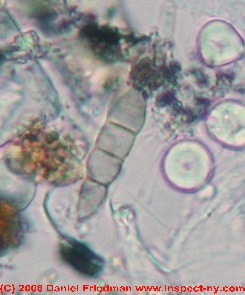 Allergenicity is also unknown. The photograph of [probably] Fusariella bizzozeriana shown here was found in an indoor dust sample by DJF.
Allergenicity is also unknown. The photograph of [probably] Fusariella bizzozeriana shown here was found in an indoor dust sample by DJF.
Other photos of Fusariella are provided by Grant Smith and sketches are in our M.B. Ellis reference below.
Fusariella sp. fungus may be found on tape samples of indoor and in air. Grows on organic material such as leaves, dead stems, and litter (many plants), possibly on wood.
[We [DJF] have identified this fungus in some attic samples where we found indications of active fungal growth, possibly on grass and leaves brought into the building by birds or rodents, and contaminating nearby fiberglass building insulation].
Fusariella sp. can travel long distances in air, as reported found in smoke from Yucatan [Fungal spores are transported long distances in smoke from biomass fires, Mims & Mims, 2003]
Identification references for Fusariella sp. fungal spores
and Fusariella sp. conidiophores (long phialidic with collarettes, spores often in chains) include Fusareilla atrovirens, F. indica, F. hughesii, F. bizzozeriana, F. concinna, F. obstipa, F. intermedia, F. kansensis, F. aegyptiaca, and F. sarniensis.
Ellis indicates that all of these are usually 3-septate: Dematiaceous Hyphomycetes and More Dematiaceous Hyphomycetes, M.B. Ellis.]
Fusarium sp. - A common soil fungus found on a wide range of plants and often found in humidifiers and water-damaged carpets.
Hard to find in air samples because the spores may be slimy. Several species in this genus can produce potent trichothecene toxins.
The trichothecene (scirpene) toxin targets, the following systems: circulatory, alimentary, skin and nervous. Produces vomitoxin on grains during unusually damp growing conditions. Symptoms may occur either through ingestion of contaminated grains or possibly inhalation of spores.
The genera can produce hemorrhagic syndrome in humans (alimentary toxic aleukia).
This is characterized by nausea, vomiting, diarrhea, dermatitis, and extensive internal bleeding.
Reported to be allergenic. Frequently involved in eye, skin and nail infections. -- U. Minn. And others.
Produces toxins at lower temperatures than many other fungi; invades corn, barley; Reported by others as associated with allergies, asthma, mycotoxin production, and in immune-impaired people, can cause infection.
Fusarium solani: Macroconidia dimensions 27-52 x 4.4-6.8; Microcondia dimensions 8-16 x 2-4u. Found in plants and soils. Can produce trichothecene toxins which may be associated with disease in humans and animals [Op.Cit. Mould Allergy , Yousef Al-Doory et als.] - U. Minn.
Eye Infections, caused by Fusarium keratitis were linked to lens cleaners: the U.S. CDC indicates that 191 cases were reported related to contaminated contact lens cleaner solutions from Baushch & Lomb, Advanced Medical Optics, and Alcon.
Potentially blinding eye infections can result (according to an attorney representing the first reported victim to lose an eye) (C.C. Warriner III, West Palm Beach, FL.).
The companies and federal agencies involved disputed the lawyer's chartges.
-- "191 Reports of Eye Infections Linked to Lens Cleaners," New York Times, 3 May 2006, Barnaby J. Feder, P. C4.
Bausch & Lomb are now (5/6/2006) studying their packaging and ingredients because although there is evidence of Fusarium keratitis blinding fungal eye infections associated with use of their contact lens cleaner ReNu with MoisureLoc lens solution, the company has observed that Fusarium contamination was not observed at the U.S. Greenville factory, and some countries that received the solution from Greenville (Indonesia, Phillipines) have not reported an unusual increase in the infection rate.
The product has been withdrawn by the company during the investigation. -- from an article by Barnaby J. Feder, New York Times, 6 May 2006, p. C3.--DF
G
Ganoderma sp.: A common spore found in outdoor air, released from a shelf fungus which grows on trees; While this genera has seasons of high spore release, I find this spore in outdoor air samples nearly all year.
The common species I find are G. applantum and G. tsuge.We have no information indicating toxicity or allergenicity of these basidiomycetes.
Geotrichum sp- A common contaminant of grains, fruits, dairy products, paper, textiles, soil and water, and often present as part of the normal human flora. The species Geotrichum candidum can cause a secondary infection (geotrichosis) in association with tuberculosis.
This rare disease can cause lesions of the skin, bronchi, mouth, lung and intestine. -- U. Minn.
Genera (genus-singular): one of the principal ranks in the naming structure of organisms, this is the first part of the standard two-part species name genera species, for example Aspergillus niger.
A given genera e.g. Aspergillus, may be made up of many species members, and individual species may vary considerably in their importance to human health.
Species - (abbreviated sp.) - the lowest principal rank in the nomenclatural hierarchy [for living organisms], consisting of two elements (a binominal): a generic name ["family"] and a species epithet [specific individual member in the family.
A genera such as Aspergillus may have more than 100 species, each with different potential medical and other effects.
Finally, the potential medical effects of an individual species may themselves vary depending on growth conditions such as choice of nutrient substrate, stage in sexual development of the organism, and other factors.] - taken in part from Dictionary of the Fungi, 9th ed., Kirk, et als. [annotations by DJF].
In some instances the contents of an indoor sample (air, dust, surface, etc) may contain particles which permit
determination of the mold genera, but not the species. In this case we report the finding name as "genera sp." such as
Aspergillus sp. rather than the more-detailed example "Aspergillus
Where appropriate additional work can often be ordered for such samples in order to determine the individual species as well.
Gliocladium sp.: A fungus which is structurally similar to Penicillium sp. Reported to be allergenic [Op. Cit. Burge, H.A. 1985. "Fungus allergens,"]. - U. Minn. "Gliocladium sp. are not known to be a human pathogen." Fundamentals of Diagnostic Mycology, Fisher & Cook, p. 71. It is not cited at all in the Atlas of Clinical Fungi, de Hoog et als. --DJF
Gliomastix sp.: Gliomastix murorum is the type species for this genera, also referred-to as Acremonium murorum - see www.sciences.adelaide.edu.au/research/resources/mycology.html for a sketch.
Some sources (such as Doctorfungs website below) distinguish between some Gliomastix species and Acremonium species, asserting that G. murorum produces "olive-green to greenish-black colonies and chains or balls of dark conidia." M.B. Ellis, our senior expert in the field, equates them in his texts.
"Acremonium is a filamentous fungus known to cause opportunistic infections in immunocompromised patients, such as the bone marrow transplant recipients - .Acremonium is one of the causative agents of eumycotic white grain mycetoma.
[Plant pathogen] Rare cases of onychomycosis, keratitis, endophthalmitis, endocarditis, meningitis, peritonitis, and osteomyelitis due to Acremonium have also been reported [see reference links at the following website].
This fungus is known to cause opportunistic infections in immunocompromised patients, such as bone marrow transplant recipients [see web ref]. Infections of artificial implants due to Acremonium sp. are occasionally observed [see web ref]." - www.doctorfungus.org
Acremonium sp. (Cephalosporium sp.) - "Reported to be allergenic.
Can produce a trichothecene toxin which is toxic if ingested. It was the primary fungus identified in at least two houses where the occupant complaints were nausea, vomiting, and diarrhea. Asexual state of Emericellopsis sp., Chaetomium sp., and Nectripsis sp.
It can produce mycetomas, infections of the cornea and nails." - U. Minn. [See Gliomastix sp. discussion.]
Non-fungal granular debris: commonly found in house dust samples, often dominated by gypsum or plaster particles.
At elevated levels these materials may be a respiratory irritant, often alkaline, and have been associated with chronic respiratory illness and hypersensitive disorders.
H
Helmintosporium sp. common in air, seasonal and more likely to be in air on hot dry days; parasites of cereals and grasses, also in soil and on textiles; allergenic bronchopulmonary mycosis has been reported per labspec.co.az
Histoplasma sp.: A fungus which has filamentous growth at 25 degrees C and yeast growth at 37 degrees C. It is reported to be a human pathogen. It may be associated with birds. - U. Minn.
Humicuola sp.: Grow on products with a high cellulose content. These fungi are also found in soil and on plant debris. [Smith's Introduction to Industrial Mycology, 7th edition, A.H.S. Onions, D. Allsopp, H.O.W. Eggins. Edward Arnold (Publishers) Ltd. London, UK, 1981.] - U. Minn.
Hyaline Mycelia: Sterile mycelia which is white or transparent. No fruiting structures are produced by the mycelia. Visual identification of these organism is not possible. Often associated with allergic symptoms. - U. Minn.
Hyphal fragments or mycelia are components of fungal growth (similar to the roots and branches of a tree); it is common to find small hyphal fragments in outdoor air and possibly in indoor dust. But their presence in indoor air samples, if in quantity or in large segments, suggests an active fungal colony in the building.
Their presence in a surface sample in quantity or in large segments indicates that active fungal growth is present or nearby, or that fungal material has been disturbed in the building. May be allergenic. -DF
See MOLD HYPHAL FRAGMENTS for additional discussion.
I
Insect parts: if present in large quantity, carpet beetle hair, fly hairs, and insect scale are all indications of moisture at levels to support insect and mold growth even though it's below the level visible to naked eye. Insect parts may be highly allergenic, as may their fecal pellets and dust particles of the same.
Interior trench-and-drain systems: IF basement or crawl space water entry in the building continues after attending my exterior recommendations cited above you may consider installation one or more interior trench-and drain systems to drain to a sump pit which in turn, ideally, drains to daylight (or is pumped with a battery backup).
This is a costly procedure, particularly for crawl spaces, and it is less preferable than preventing water entry in the first place.
Furthermore some such systems only prevent wet floors, not high interior moisture.
For these reasons I recommend deferring this measure until the less costly and more obvious outdoor maintenance and corrective items have been addressed and the result of that effort evaluated.
J
K
L
Leptosphaeria sp. "Can cause allergic diseases and asthma attacks. Cause of rhinitis and skin infections." - Aerobiology Research Labs.
Limited invasive inspection always must leave some risk of un-discovered mold or other allergens in a building.
The building leak history, observation of leak stains and other visual clues, and examination of strategically-collected samples of building dust and debris can combine to provide an acceptably-confident evaluation of building conditions, balanced with the need to limit the amount of demolition at a property.
M
Memnoniella - Memnoniella/Stachybotrys.
These two spores are very similar and are close relatives; the spore structure on a few hyphae (stem fragments) and conidiophores (spore producing structure) are consistent with Stachybotrys and key as that spore.
However, most spores in the sample are spherical (Stachybotrys spores are commonly oblate but can be spherical) and in chains, indicating Memnoniella spores.
These mold spores are treated by most references as identical.
They are considered potentially allergenic, toxigenic, and opportunistic.
See http://www.bsu.edu/web/IEN/archives/060200.htm for recent comments on Memnoniella/Stachybotrys.
http://www.thefairways.com/literature.htm and http://www.epa.gov/nerlcwww/2001.htm support treat Memnoniella and Stachybotrys as pathogenically the same.
Meruliporia incrassata: There is risk of severe structural damage from this wood destroying fungus - investigate further and remove all infected wood plus 12-24" past last sign of infection.
Poria
incrassata and Merulius lacrymans are two Basidiomycetes that cause brown rot, sometimes called "dry
rot" since these fungi can transport their own water over great distances into a building structure and can continue to
cause damage even when the building appears "dry".
Meruliporia links:
http://www.human.cornell.edu/dea/extension/docs/fal96/fungi.htm
http://www.psms.org/sporepr/sp351.html
http://www.ucfpl.ucop.edu/HOTopics.htm
Microsporum sp.: Causes ringworm in humans [Op.Cit. Medically Important Fungi - A Guide to Identification] - U. Minn.
Mite fecals: commonly found, these indicate the presence of dust mites and related allergens.
Mite fecals and other insect fecals and parts are allergenic and can be a severe risk to asthmatics. Dust mites are microscopic relatives of spiders. They live in bedding, upholstered furniture, carpeting, curtains, and they feed on skin flakes from humans and animals.
They are found in every property.
See http://www.niehs.nih.gov/airborne/prevent/mites.html for more suggestions on mite control.
Mildew: an obligate parasite form of mold that grows on living plants.
See MILDEW PHOTOGRAPHS for details.
Mildew: Among the major groups of molds is a very large mold family, Basidiomycota (or basidiomycetes); this family in turn includes, among the many Basidiomycota members, we find a relatively small sub-group, the Ustilaginales, also familiarly called Smuts and Mildews.
Both smuts and mildews are parasites of living plants and cause serious crop damage as well as damage to ornamental shrubs.
See Kiss et als. for an example of mildew damage to tomatoes. Common mildews are divided into two sub-groups,
- Oidium-Erysiphe, familiarly named Powdery Mildew
- Peronosporaceae, familiarly named Downy Mildew
Mitospores - this is an artificial collection of a large group of fungi which is used by aerobiologists to refer to members of the deuteromycete class of asexual fungi which could not be identified to genera/species in the particular sample.
Many of these have been related to the ascomycetes or basidiomycetes groups.
If a spore is recognizable as a specific genera or genera/species, particularly one which is already known to be problematic in indoor air it will be so-named and will not be reported in this group.
Monilia sp.: Reported to be allergenic [Op. Cit. Burge, H.A. 1985. "Fungus allergens,"]
. This fungus produces soft rot of tree fruits. Other members produce a red bread mold.
It is infrequently involved in corneal eye infections [Op.Cit. Smith's Introduction to Industrial Mycology,] [Op.Cit. Medically Important Fungi - A Guide to Identification] . - U. Minn.
Moniliella sp.: M. acetoabutens (reported as Moniliella suaveolens, cf deHoog), anamorphic Ascomycete, a basidiomycetous yeast-like genus pylogeneticlaly close to Trichosporon. Pathogen: skin leisons on the palms.
- Paraphrased from Atlas of Clinical Fungi, deHoog et als. This yeast-like fungus may be airborne - see " Biodiversity and concentration of airborne fungi in a hospital environment," Johannes Rainer, Ursula Peintner and Reinhold P�der, Mycopathologia, Springer Science+Business Media B.V., Formerly Kluwer Academic Publishers B.V. ISSN: 0301-486X (Paper) 1573-0832 (Online), and may be associated with certain yeast infections (http://wlapwww.gov.bc.ca/wat/wq/reference/fungi.html) -DF
Monodictys sp.: no information on allergenicity was located in my clinical medical references, suggesting that this fungus has not been identified as a pathogen or serious allergen for humans.
Some species of this fungus grow on wood and have been found on water-damaged wood indoors. It is occasionally confused with Stemphylium (which grows more often on herbaceous plants and less often on wood).
Occasionally also confused with Ulocladium sp. Uncommon in air. Soil and Seed Fungi, Pictorial Atlas, 2d ed., Tsuneo Watanabe, CRC Press 2002 equates the appearance of this fungus with the aleuriosporous form of Neta quadriguttata. M. asperospora has been found on sheep dung.
Microfungi on Miscellaneous Substrates, Martin B. Ellis, J. Pamela Ellis, Timber Press 1988. Ellis (Dematiaceous Hyphomycetes and More Dematiaceous Hyphomycetes) reports this fungus on twigs, apple trees, oak, and other plants and soil composites.-DJF Monodictys sp. was not cited in common clinical fungi references which concern fungal species which are pathogens.
Where this mold has been found observers should be alert for other fungal species as mold-conducive conditions are present.
This fungus may be a wood-rotter, as Ellis has reported its growth on organic substrates (bones, paper, cloth,etc.) - DJF,
Ref: Microfungi on Miscellaneous Substrates, an Identification Handbook, Martin B. Ellis & J. Pamela Ellis, Croom Helm, London, 1988, ISBN 0-7099-5316-X. , Ref: Microfungi on Miscellaneous Substrates, an Identification Handbook, Martin B. Ellis & J. Pamela Ellis, Croom Helm, London, 1988, ISBN 0-7099-5316-X.
Mortierella sp.: Diseases associated with members of Mortierella sp. See www.emedicine.com/ent/topic639.htm - regarding fungal sinusitis and www.doctorfungus.org/mycoses/human/zygo/zygomycosis.htm - regarding zygomycosis
Mucor - a rapidly growing fungus, usually dark gray or light olive gray when grown on typical laboratory media. Mucor, together with Rhizopus, is one of the most quickly invading organisms able to contaminate many kinds of stored food products.
Mucor has worldwide distribution and is often found in hay, stored seeds, horse manure and house dust, regardless of geographical location.
Mucor is also frequently found in air samples from indoor environments.
Accumulated dust in HVAC systems and poorly maintained carpeting may contain high concentrations of Mucor spores.
One study of the most frequent molds found in house dust in samples of homes found Mucor in 98% of the samples from homes in Denmark and 31% of the samples in homes in Canada.
Heavy exposure to the spores of Mucor can cause extrinsic allergic alveolitis, a type 3 (IgG) allergic response. It is generally associated with occupational exposure to wood chips and sawdust.
The symptoms, which occur 6-8 hours after exposure include: elevated temperature, flu-like symptoms, general malaise, difficulty breathing and later asthma.
Eliminating Mucor mold exposure before the onset of pulmonary fibrosis usually leads to a return to a normal, healthy state.
Mucor is also a rare opportunistic pathogen, attacking individuals with significantly compromised immune systems, metabolic acidosis, uncontrolled diabetes, starvation, severe trauma or other forms of debilitation. -- Aerolabs; labspec.co.za Also: "A Zygomycetes fungus which may be allergenic ( skin and bronchial tests) Reported to be allergenic [Op. Cit. Burge, H.A. 1985. "Fungus allergens,"]. 17).
This organism and other Zygomycetes will grow rapidly on most fungal media.
May cause mucorosis in immune compromised individuals [Op.Cit. Medically Important Fungi - A Guide to Identification]. The sites of infection are the lung, nasal sinus, brain, eye and skin [Op.Cit. Medically Important Fungi - A Guide to Identification] .
Infection may have multiple sites [Op.Cit. Medically Important Fungi - A Guide to Identification] ." - U. Minn.
Mycelium - the entire mass of hyphae that constitutes the vegetative [non-sporulating] body or thallus of a fungus. - Illus. Dictionary of Mycology, Ulloa & Hanlin.
A mycelium is a mass of fungal hyphae; hyphae are long chains of fungal cells which form the growing/feeding component of a fungus.
Spores may not be present with some hyphae, and may be produced only when environmental conditions encountered by the hyphae stimulate it to produce, and perhaps release fungal spores. When hyphae are present without any evidence of fungal spores or spore-producing bodies I refer to such growths as "sterile hyphae."
Mycelia: a mass of hyphae; the thallus of a fungus, this is the vegetative body portion of the organism, akin to the "root" structure of a plant, used to absorb nutrients.
Mycelia would not easily be visually identifiable as belonging to a specific species unless other components of the fungus are present. Particles of this material are probably allergenic. - DF; derived from "Dictionary of the Fungi," 9th Ed., Kirk, Cannon, David, and Stalpers.
Mycetoma: [paraphrasing the reference source] a chronic granulomatous infection, typically on one of the extremities.
About half are caused by fungi, the others by bacteria. All are subcutaneous infections characterized by swollen, tumor-like areas with sinuses that drain through multiple sinus tracts. For more information see my source: Fundamentals of Diagnostic Mycology, Fisher & Cook, p. 158.
Mycotoxin - Reference list: http://www.ttuhsc.edu/SOM/Microbiology/mainweb/aiaq/FungalReferenceGuide/withoutframes/Main%20page/MycoRefAb.htm
N
Nephaline syenite: a material used in glazes and paints, may pose respiratory hazards and appears in a variety of MSDS available online. Also see Clay, Talk, Nephaline syenite, Cornwall Stone.
Nigrospora sp. - Nigrospora sphaerica - Reported to be allergenic (Burge, H.A. 1985. "Fungus allergens," Clin. Rev. Allergy , 3:19-329.);
Nigrospora oryzae found in corn and peanuts may be toxic or carcinogenic (Pilt JL, Hocking AD, Bhudhasa et als); "Nigrospora has been isolated from cutaneous lesions of a leukemic patient and from a case with keratitis.
However, its pathogenic role as a causative agent is not well-known." (doctorfungus.org) Aerobiology Research Labs. has similar opinion regarding allergenicity.
O
Oidium sp.: widespread anamorphic fungi such as Erysiphe; a mildew, also called oidiospores or arthrospores such as Geotrichum candidum, a (teleomorph) form of an ascomycetous yeast, may be associated with Candida infections.
"The main human disorders caused by G. candidum are colonization of the intestinal tract and bronchial or pulmonary infections in humans as well as in other mammals. - Blood-stream infection with sepsis is occasionally noted." - Atlas of Clinical Fungi, deHoog et als - DJF.
See MILDEW PHOTOGRAPHS for details.
Ophistoma - see Ceratocystis/Ophistoma group
P
Paecilomyces sp. - Commonly found in soil and dust, less frequently in air. P. variotii can cause paecilomycosis.
Linked to wood-trimmers disease and humidifier associated illnesses. They are reported to allergenic. Some members of this genus are reported to cause pneumonia.
It may produce arsine gas if growing on arsenic substrate.
This can occur on wallpapers that contain colour pigments using Arsenic green or Scheele green, Paris green -- U. Minn -
see WALLPAPER ARSENIC + MOLD POISONING
This fungus is a contaminant/opportunistic pathogen found worldwide in soil and decaying vegetation. Important from a health-concern view, the spores are airborne [and small]. Occasionally it has been reported as a pathogen in pulmonary infections, endocarditis, and sinusitis.
Infections of cutaneous lesions have occasionally occurred after traumatic inoculation of the host.
Paecilomyces sp. have been associated with infections in patients who have had organ transplants. May be found in respiratory secretions, tissue biopsy specimens, blood, and aspirates from abscesses.
- Fundamentals of Diagnostic Mycology, Fisher/Cook, paraphrased by D. Friedman. P. crustaceous has been isolated from a bronchial lavage of a patient with pulmonary infarction; it was grown repeatedly from monocyte cultures of patients suffering with AIDS and has been reported as causing peritonitis. - Atlas of Clinical Fungi, 2nd ed., deHoog et als, paraphrased by D. Friedman.
Particulates - see "Sub-Micron Particulates" below.
Penicillium/Aspergillus spores in air: There is no official standard for acceptable mold spore levels. To create such a guide would require standards for each of possibly thousands of genera/species and conditions.
However "clean" residential buildings are typically 230/m3 +630/-230.
Buildings with evidence of flooding are typically much higher: 2200/m3 and mold-damaged buildings are typically extremely high in comparison: 36,000/m3.
I usually find only trace levels of Pen/Asp indoors, so higher counts make further investigation a reasonable course of action, particularly where occupants may be at extra risk due to fragile health.
 Penicillium is a common fungus often found growing in buildings where moisture problems are present.
Colonies on building surfaces can be difficult to see without careful inspection.
Penicillium is a common fungus often found growing in buildings where moisture problems are present.
Colonies on building surfaces can be difficult to see without careful inspection.
They may appear light in color, ranging from white to blue to green.
I often find this genera growing on previously wet-drywall, but more distant from the source of moisture than some other genera often found in these locations like the easier-to-spot Stachybotrys chartarum.
Penicillium mold is commonly considered an allergen and a producer of a number of mycotoxins, each of which may have different effects which may also vary in different individuals.
Because the Penicillium sp. genera is more difficult to see in-situ in buildings and since its spores are more difficult to spot under a microscope (colorless and small, about 2 to 3 u) I suspect that this genera is under-reported in both field and laboratory work.
Yet because it is more easily airborne than the media-popularized Stachybotrys chartarum, and because its smaller spores (2u rather than 10-12u) may be breathed deeply into the lungs, I suspect it is more likely to be an airborne problem in buildings.-DJF
Penicillium sp. "A wide number of organisms have placed in this genera. Identification to species is difficult.
Often found in aerosol samples. Commonly found in soil, food, cellulose and grains. It is also found in paint and compost piles. It may cause hypersensitivity pneumonitis, allergic alveolitis in susceptible individuals.
Penicillium mold is reported to be allergenic (skin). It is commonly found in carpet, wallpaper, and in interior fiberglass duct insulation.
Some species can produce mycotoxins.
Common cause of extrinsic asthma (type-type hypersensitivity: type I). Acute symptoms include edema and bronchiospasms, chronic cases may develop pulmonary emphysema." -- U. Minn.
"The common occurrence of Penicillium in food is a particular problem. Some species produce toxins and may render food inedible or even dangerous. It is a good practice to discard foods showing the development of any mould.
On the other hand, some species of Penicillium are beneficial to humans.
Cheeses such as Roquefort, Brie, Camembert, Stilton, etc. are ripened with species of Penicillium and are quite safe to eat. The drug penicillin is produced by Penicillium chrysogenum, a commonly occurring mold in most homes." -- U. Toronto.
Most Penicillium spores are toxigenic or allergenic. Some are more toxic than industrial cancer-causing substances and are acutely toxic to the liver, brain, kidneys, and heart. Symptoms of acute aflatoxicosis are fever, vomiting, coma, and convulsions.
Symptoms that occur in most moderately contaminated buildings are not fully known but are expected to be less severe.
Keep in mind that my lab work does not identify the sub-species of this genus so we do not know if very dangerous species are present in the building.
However given the risks of serious illness cleanup should be handled carefully and with expert advice. People with other illnesses or compromised immune systems (chemotherapy, bronchiectasis, carcinoma, or other mycoses) are at particular risk.
Any environment where this mold/fungus is found is a potential health hazard.
"Penicillium species have been shown to be fairly common indoors, even in clean environments, but certainly begin to show up in problem buildings in numbers greater than outdoors ( Burge, 1986; Miller et al., 1988; Flannigan and Miller, 1994).
Spores have the highest concentrations of mycotoxins, although the vegetative portion of the mold, the mycelium, can also contain the poison.
Viability of spores is not essential to toxicity, so that the spore as a dead particle can still be a source of toxin." -- "Is Indoor Mold Contamination a Threat to Health?" - Harriet M. Ammann, Ph.D., D.A.B.T.Senior Toxicologist Washington State Department of Health
Penicillium Diseases: "Rare agent of infection, cases of keratitis, peritonitis, and systemic disease reported for species other than P. marneffei. P marneffei is the major pathogen in the genus. It is the etiologic agent of penicilliosis marneffei a systemic disease in immunocompromised hosts." -- U. Texas
Periconia: no information available; watch Univ. of Minnesota for future data.
Perithecia, Cleistothecia, or similar fungal bodies are fungal fruiting bodies formed to store and protect fungal spores, for example when moisture conditions or lack of food create hostile growing conditions.
They may not be identifiable to genera/species without additional culture steps. In absence of other medical information I would consider this material possibly allergenic.
The most common perithecia we find in buildings is for Chaetomium sp., a fungus associated with moisture and wood soft-rot. Chaetomium is reported to be allergenic.
Peronospora: Peronosporaceae, familiarly named Downy Mildew See MILDEW PHOTOGRAPHS for details.
Phoma sp. - A common indoor air allergen. It is similar to the early stages of growth of Chaetomium sp.
The species are isolated from soil and associated plants (particularly potatoes). Produces pink an purple spots on painted walls. It may have antigens which cross-react with those of Alternaria sp.. It will grow on butter, paint cement and rubber. It may cause phaeohyphomycosis a systematic or subcutaneous disease. -- U. Minn.
"In exceptional cases, a cause of infections in humans or animals. To date only a few cases of subcutaneous phaeohyphomycosis have been reported." - Identifying Filamentous Fungi, a Clinical Laboratory Handbook, St-Germain & Summerbell & Atlas of Clinical Fungi, deHoog et als. contains key identification features to distinguish from ascomycetes. - DJF
Phialophora sp. found in soil, water, dung, wood and plant debris; According to U. Toronto (botany department, www.botany.utoronto.ca, (MallochLab), this genera is similar to Exophiala with only subtle differences. Wang/Zabel combine these genera.
According to fungusweb.utmb.edu this genera has been associated with chromoblastomycosis, phaeohyphmycosis, and keratitis as a human pathogen.
Other refs: "Identification Manual for Fungi from Utility Poles in the Eastern United States," Wang & Zabel. "Fungusweb" at the U. Texas Medical Branch, department of Pathology, does not call for special handling precautions other than ordinary care.
P. heteromorpha = Exophiala jeanselmei [deHoog et als],was documented as attacking wood products. This source (WZ) also provides a key to human pathogenic species of Phialophora, citing: P. richardside, P. verrucosa, and P. repens. doctorfungus.org cites this genera as follows: "Phialophora species are among the causes of chromoblastomycosis and phaeohyphomycosis.
Phialophora verrucosa is the principal causative agent of chromoblastomycosis in tropical and subtropical areas, particularly at Japan and South America.
The clinical forms of phaeohyphomycosis may be diverse, including cutaneous infections, subcutaneous cysts, keratitis, endocarditis, arthritis, osteomyelitis, cerebral infection, fatal hemorrhage, and disseminated infection [1879, 549, 1266].
Phialophora europaea has been isolated from cutaneous and nail infections in North-western Europe [485]."
See notes for Exophiala. Phialophora parasitica - "The original isolate of P. parasitica was from a subcutaneous lesion in man (Ajello et al. 1974).
It also caused diseases in woody plants in Iraq, Tunisia,
Pithomyces. (P. chartarum is most commonly isolated species.) Common outdoors, grows on decaying plants and organic matter. P. Chartarum produces a mycotoxin called sporidesmin which causes liver necrosis in sheep, a sometimes-fatal disease. -- The Fifth Kingdom, Kendrick, p. 326.
Also: http://nt.ars-grin.gov/index.htm Systematic Botany & Mycology Laboratory, USDA, Beltsville MD.
Plaster and mold risk: Where we cannot find other evidence of mold contamination within a wood-framed plaster wall, and where there are not significant mold odors, leaving plaster in place can be an acceptable procedure.
I do not often find significant mold growth on plaster except on painted or dirty plaster surfaces.
We speculate based on field and lab investigation experience that the alkaline nature of the material is a retardant to many fungal species. If plaster develops a moldy odor it may be possible to "cure" the problem by surface cleaning and use of a sealant
. If these clues are indicators of a wet wall cavity there is still risk of fungal spores on wood surfaces within the wall.
Pleospora sp. - no medical data; however see my notes regarding Stemphylium sp. (Pleosporum);
Pollen: it is typical to find at least a few pollen grains in an indoor air sample; pollen is often allergenic and may contribute to or trigger other respiratory illness and some forms of asthma. Pollen levels vary widely with season, wind, weather, temperature, rainfall, and other conditions.
Pollen found indoors in seasons where it is not expected in outdoor air may indicate an indoor dust and pollen reservoir such as a dirty HVAC system. Pollen grains are plant particles, not fungal spores.
Pycnidia: a flask-shaped conidioma of fungal tissue with a circular or longitudinal ostiole, the inner surface of which is lined entirely or partially with conidiogenous cells. See Phoma for example.
QR
Riessia sp. is a basidiomycete which has been reported as a wood saprophyte - growing on rotting wood. My clinical texts do not cite medical data for this fungus.
Where found in buildings you should consider this a water-indicator fungus which means that you should be alert for other, problematic molds or water-related damage. - DJF
Rhizomucor sp.: The Zygomycetous fungus - reported to be allergenic [Op. Cit. Burge, H.A. 1985. "Fungus allergens,"]. It may cause mucorosis in immune compromised individuals. It occupies a biological niche similar to Mucor sp.
It is often linked to occupational allergy [Op.Cit.Atlas of Moulds in Europe causing respiratory Allergy]. May cause mucorosis in immune compromised individuals [Op.Cit. Medically Important Fungi - A Guide to Identification] .
The sites of infection are the lung, nasal sinus, brain, eye and skin [Op.Cit. Medically Important Fungi - A Guide to Identification] . Infection may have multiple sites [Op.Cit. Medically Important Fungi - A Guide to Identification] . - U. Minn.
Rhizopus sp.: The Zygomycetous fungus - reported to be allergenic [Op. Cit. Burge, H.A. 1985. "Fungus allergens,"].
Rhizopus may cause mucorosis in immune compromised individuals. It occupies a biological niche similar to Mucor sp. It is often linked to occupational allergy [Op.Cit. Atlas of Moulds in Europe causing respiratory Allergy] May cause mucorosis in immune compromised individuals.
The sites of infection are the lung, nasal sinus, brain, eye and skin. Infection may have multiple sites [Op.Cit. Medically Important Fungi - A Guide to Identification]. - U. Minn.
Frequently found in house dust, soil, fruits, nuts, and seeds, fruit and vegetable garbage, leftover food.
Exposure to large numbers of Rhizopus spores has reportedly caused respiratory complications.
Rhizopus can be an allergen and opportunistic pathogen for immunocompromised individuals, especially those with diabetic ketoacidosis, malnutrition, or severe burns. -- www.restcon.com/links/articles/mold_and_mildew.html
[NOTE: the cited article has some mycological inaccuracies.
For example, "mildew" named as a concern in the article does not normally appear in buildings - it grows on living plants as an obligate parasite.-- DJF]
Rhodotorula sp.: A reddish yeast typically found in moist environments such as carpeting, cooling coils and drain pans.
In some countries it is the most common yeast genus identified in indoor air This yeast has been reported to be allergenic [Op. Cit. Burge, H.A. 1985. "Fungus allergens,"].
Positive skin tests have been reported. It has colonized terminally ill patients. [Op.Cit.Atlas of Moulds in Europe causing respiratory Allergy]. [Op.Cit. Medically Important Fungi - A Guide to Identification]. - U. Minn. May also include yellow yeasts - DF
S
Saccharomyces sp.: Reported to be allergenic [Burge, H.A. 1985. "Fungus allergens," Clin. Rev. Allergy , 3:19-329.]
Scopulariopsis sp. - It may produce arsine gas if growing on arsenic substrate.
This can occur on
wallpapers covered with paris green - WALLPAPER ARSENIC + MOLD POISONING
Under wet conditions, the mold Scopulariopsis brevicaulis produced significant amounts of methyl arsines via methylation[15] of arsenic-containing inorganic pigments, especially Paris green and Scheele's Green. (Bentley 2002)
It has been found growing on a wide variety of materials including house dust. It is associated with type III allergy.
"Scopulariopsis species are usually a contaminant, but they have been recovered on numerous occasions from patients with onychomycosis. It is a rare cause of pneumonia, keratomycosis, otitis, and septicemia."-Fisher & Cook, Fundamentals of Diagnostic Mycology.
Also see St-Germain & Summerbell, Identifying Filamentous Fungi, a clinical laboratory handbook: Onchomycosis is occasionally reported; subcutaneous and pulmonary infection are rare and primarily affect people who are immunocompromised. --DF
Serpula lacrymans - Common cause of extrinsic asthma (immediate-type hypersensitivity: type I). Acute symptoms include edema and bronchiospasms, chronic cases may develop pulmonary emphysema.
Smut: "Members of the order Ustilaginales, known as smut fungi, create black, dusty spore masses on the plants they infect.
There are approximately 1,200 species of smuts within 50 genera (Vanky, 1987)." - Estelle Levetin, U. Oklahoma, "Mycology of the Air," Haines et als, October 2000. Two large genera are Tilletia and Ustilago. These are plant pathogens on cereals.
Smuts also grow on grasses. Smut teliospores are allergenic, with Tilletia peaking in late summer (August-September) and Ustilago early summer (June-July).
I have not found reports of human infection from this fungus. - DJF 2002
Sporotrichum - commonly considered nonpathogenic. A few cases of repeated isolation of Sporotrichum pruinosum from respiratory secretions are suggestive of a bronchopulmonary colonization.
This is a common fungus isolated from decaying wood and from soil, anamorphs of basidiomyceteous fungi which are important agents of wood decay.
Look for wood rot damage in structures where this fungus is found - DJF & "Identifying Filamentous Fungi, A Clinical Lab Handbook", St-Germain & Summerbell.
Species - (abbreviated sp.) - the lowest principal rank in the nomenclatural hierarchy [for living organisms], consisting of two elements (a binominal): a generic name ["family"] and a species epithet [specific individual member in the family.
A genera such as Aspergillus may have more than 100 species, each with different potential medical and other effects.
Finally, the potential medical effects of an individual species may themselves vary depending on growth conditions such as choice of nutrient substrate, stage in sexual development of the organism, and other factors.] - Dictionary of the Fungi, 9th ed., Kirk, et als. [bracketed annotations by DJF].
In some instances the contents of an indoor sample (air, dust, surface, etc) may contain particles which permit
determination of a mold genera, but not the species. In this case we report the finding name as "genera
sp." such as Aspergillus sp. rather than the more-detailed example "Aspergillus
Where appropriate additional work can often be ordered for such samples in order to determine the individual species as well.
Spore, conidia, or "fungal spore," "a small unit of propagation, - capable of giving rise to a new individual. A spore functions like a seed. - Spores can be spread by air, water, insects, or other animals. Illustrated Dictionary of Mycology, Ulloa and Hanlin [paraphrased by DF]. In buildings airborne spores are the ones likely to be of greatest risk to humans, although certain other spores which are not intended to be spread in air can be infectious if placed directly in an eye, an open cut, or on other sensitive tissues. -DF
Sporidesmium (over 60 species).
Found on dead twigs, leaves, cedar planks, dead wood of oak, and other wood material. No medical information is cited in my clinical references; this mold may be allergenic. When found indoors I associate it with wet conditions and rotting wood.
You should consider it an indicator organism, showing wet conditions, and you should be alert for other problematic molds in the area. -DF
Sporobolomyces sp.: Reported to be allergenic [Op.Cit. Burge, H.A. 1985. "Fungus allergens,"]. - U. Minn.
Sporothrix sp.: Can cause sporotrichosis. Usually only in populations which are immune compromised. - U. Minn. (S. schenckii): " - found worldwide in soil, vegetable debris, moist wood, wood pulp, sphagnum moss, and some fertilizers - infection is associated with gardening - nicknamed rose gardener's disease'" may also be associated with aquaria.
A cause skin mycoses characterized by development of ulcers and abscesses along the lymphatic channels; most infections area caused by traumatic inoculation of the fungus into the host tissues but infection can be contracted by inhalation." Fundamentals of Diagnostic Mycology, Fisher & Cook.
According to Identifying Filamentous Fungi, A Clinical Laboratory Handbook, St-Germain & Summerbell, it " - also [besides skin ailments] may rarely manifest in an opportunistic respiratory or disseminated form which affects humans and animals."
Sporotrichum sp.: Reported to be allergenic [Op.Cit. Burge, H.A. 1985. "Fungus allergens,"]. See also Sporothrix sp.. there is some taxonomic confusion between these two genera.
This genera does not cause sporotrichosis. - U. Minn. St-Germain/Summerbell report Sporotrichum as commonly considered non-pathogenic, with a few cases of repeated isolation of Sporotrichum pruinosum from respiratory secretions as suggestive of a bronchopulmonary colonization. -Identifying Filamentous Fungi, St-Germain and Summerbell.
Stachybotrys chartarum (previously referred-to as Stachybotrys atra) colonizes high-cellulose material (cellulose, paper on gypsum board) in areas where temperature is right (2-40�C) and where there is cyclic water/wet activity (such as basement water entry).
This fungus can produce several toxins which affect the human immune system. The US EPA and the Cleveland Dept. of Health speculate that this fungus may be responsible for a cluster of acute pulmonary hemolysis/hemosiderosis cases from 1993 to present and in which nine of 36 infants from these homes died.
Adult symptoms include immune suppression, bleeding, and adverse reproduction effects. These are serious threats to health but this is a new topic and much research remains to be done.
Any environment where this mold/fungus is found is a potential health hazard. -- U. Minn. Dept. of Environmental Health & Safety and others.
Mold Inspection & Testing Warning: where this mold is found you should consider it an "indicator organism" showing that wet building conditions have been present. Wet building conditions usually produce more than a single mold genera/species in the environment.
Different genera/species may be found growing on different building materials (e.g. drywall vs. wood vs. insulation). Different genera/species may be found growing on the same building material in different areas depending on variations in material moisture (wetter drywall near a wet floor producing S. chartarum vs. less wet material higher on the same wall producing genera/species more difficult tot see, such as lighter-colored Aspergillus sp., or different genera/species on the drywall exterior from that found inside the wall cavity).
Therefore where this mold you should be alert for the possible presence of other, possibly more harmful (more airborne) molds in the building. Further investigation may be appropriate.
Stachybotrys chartarum spores in air are a strong indication of a significant fungal contamination in the building as this species is not easily airborne.
Here is additional detail quoted from the University of Minnesota Environmental information web: Several strains of this fungus (S. atra, S. chartarum and S. alternans are synonymous) may produce a trichothecene mycotoxin- Satratoxin H - which is a poisonous by inhalation.
The toxins are present on the fungal spores. This is a slow growing fungus on media. It does not compete well with other rapidly growing fungi.
The dark colored fungi grows on building material with a high cellulose content and a low nitrogen content. Areas with relative humidities above 55% and are subject to temperature fluctuations are ideal for toxin production [Op. Cit. Mycotoxicology - Introduction to the Mycology...] [Op. Cit. Croft. W.A., Jarvis, B.B., and Yatawara, C.S.].
Individuals with chronic exposure to the toxin produced by this fungus reported cold and flu symptoms, sore throats, diarrhea, headaches, fatigue, dermatitis, intermittent local hair loss [Manville, C. 1996. Poor drainage leads to fungal infestation, Adverse health effects. Indoor Air Quality Update. 3:11-12] and generalized malaise.
The toxins produced by this fungus will suppress the immune system affecting the lymphoid tissue and the bone marrow Animals injected with the toxin from this fungus exhibited the following symptoms, necrosis and hemorrhage within the brain, thymus, spleen, intestine, lung, heart, lymph node, liver, and kidney. [Croft. W.A., Jarvis, B.B., and Yatawara, C.S. 1986.
Airborne outbreak of trichothocene toxicosis. Atmos. Environ. 20:549-552] Affects by absorption of the toxin in the human lung are known as pneumomycosis [Op. Cit. Mycotoxicology - Introduction to the Mycology...].
This organism is rarely found in outdoor samples. It is usually difficult to find in indoor air samples unless it is physically disturbed or if there is (speculation- a drop in the relative humidity). The spores are in a gelatinous mass. Appropriate media for the growth of this organism will have a high cellulose content and a low nitrogen content. The spores will die readily after release.
Watch out "dead" spores of Stachybotrys chartarum are still allergenic and toxigenic. Percutaneous absorption has caused mild symptoms [Op.Cit. Medically Important Fungi - A Guide to Identification] .
See BLEACHING MOLD, Advice about
Stachybotrys chartarum (previously referred-to as Stachybotrys atra) colonizes high-cellulose material (cellulose, paper on gypsum board) in areas where temperature is right (2-40�C) and where there is cyclic water/wet activity (such as basement water entry).
This fungus can produce several toxins which affect the human immune system.
The US EPA and the Cleveland Dept. of Health speculate that this fungus may be responsible for a cluster of acute pulmonary hemolysis/hemosiderosis cases from 1993 to present and in which nine of 36 infants from these homes died.
Adult symptoms include immune suppression, bleeding, and adverse reproduction effects.
These are serious threats to health but this is a new topic and much research remains to be done.
Any environment where this mold/fungus is found is a potential health hazard. -- U. Minn. Dept. of Environmental Health & Safety and others.
Watch out: Stachybotrys Found: ld Inspection & Testing Warning: where this mold is found you should consider it an "indicator organism" showing that wet building conditions have been present.
Wet building conditions usually produce more than a single mold genera/species in the environment.
Different genera/species may be found growing on different building materials (e.g. drywall vs. wood vs. insulation).
Different genera/species may be found growing on the same building material in different areas depending on variations in material moisture (wetter drywall near a wet floor producing S. chartarum vs. less wet material higher on the same wall producing genera/species more difficult tot see, such as lighter-colored Aspergillus sp., or different genera/species on the drywall exterior from that found inside the wall cavity).
Therefore where this mold you should be alert for the possible presence of other, possibly more harmful (more airborne) molds in the building. Further investigation may be appropriate.
Here is additional detail quoted from the University of Minnesota Environmental information web:
Several strains of this fungus (S. atra, S. chartarum and S. alternans are synonymous) may produce a trichothecene mycotoxin- Satratoxin H - which is a poisonous by inhalation. The toxins are present on the fungal spores.
This is a slow growing fungus on media. It does not compete well with other rapidly growing fungi.
The dark colored fungi grows on building material with a high cellulose content and a low nitrogen content. Areas with relative humidities above 55% and are subject to temperature fluctuations are ideal for toxin production [Op. Cit. Croft. W.A., Jarvis, B.B., and Yatawara, C.S.]
Individuals with chronic exposure to the toxin produced by this fungus reported cold and flu symptoms, sore throats, diarrhea, headaches, fatigue, dermatitis, intermittent local hair loss [Op. Cit. Manville, C. 1996. Poor drainage leads to fungal infestation] and generalized malaise. T
he toxins produced by Stachybotrys will suppress the immune system affecting the lymphoid tissue and the bone marrow [Op. Cit. Mycotoxicology - Introduction to the Mycology...] . Animals injected with the toxin from this fungus exhibited the following symptoms, necrosis and hemorrhage within the brain, thymus, spleen, intestine, lung, heart, lymph node, liver, and kidney. [Op. Cit. Croft. W.A., Jarvis, B.B., and Yatawara, C.S.]
Affects by absorption of the toxin in the human lung are known as pneumomycosis [Op. Cit. Mycotoxicology - Introduction to the Mycology ...]
This organism is rarely found in outdoor samples. It is usually difficult to find in indoor air samples unless it is physically disturbed (or, speculatively, if there is a drop in the relative humidity). The spores are in a gelatinous mass.
Appropriate media for the growth of this organism will have a high cellulose content and a low nitrogen content. The spores will die readily after release. The dead spores are still allergenic and toxigenic. Percutaneous absorption has caused mild symptoms [Op.Cit. Medically Important Fungi - A Guide to Identification].
Starch granules: this material is often found where food or snacks have been consumed, or where some talcum or similar body powders are in use.
Corn starch is widely use in many consumer products besides food, including body powders and on rubber gloves.
Rice and potato starch are also often found in indoor samples. It is common for us to find starch granules in indoor dust and occasionally air samples.
We identify potato starch, corn starch, and rice starch using polarized light microscopy.
At high levels the presence of these particles may tell us something about building history - a product containing starch granules may have been in heavy use in the building, including not only toiletries but certain cleaning products.
When we find high levels of starch granules in building areas other than baths or dressing areas, a concern is raised for possible related mold growth or high levels of insect activity which in turn can produce problematic problem mold or high levels of dust mite fecals or insect fragments.
Those secondary particles may be a respiratory irritant especially to people with respiratory disorders or asthma. In such cases a review of possible starch sources, halting the use of such products in excess, and additional professional building cleaning may be in order.
Stemphylium sp. Most species are plant pathogens with occasional isolates from soil.
Stemphylium can be confused with and are difficult to distinguish from Ulocladium unless their growth structures (conidia) can be isolated or cultured.
They are rarely seen in the clinical laboratory according to the mycology reference at the University of Adelaide. --AU. S. botryosum (Pleosporum) common cosmopolitan temperate and subtropical on vegetation and in polluted water, bark, leaves of citrus; on tomatoes, wheat, barley; with Alternaria, considered a most important mold allergen in the US. -- labspec.co.az "Known allergen.
It is considered an opportunist.
Shares the same allergens as Alternaria species." - Aerobiology Research Labs.
Stemphylium mold may share the same Pathogenicity as Alternaria as well - cases of subcutaneous phaeohyphomycosis - Atlas of Clinical Fungi, 2nd ed. De Hoog et als.
You should consider this mold at least a water-indicator organism which means that conditions that produced it risk production of other problematic genera; in particular, I have found this mold present with Penicillum/Aspergillus. -- DF
From EMLAB Environmental Reporter 12/04: Stemphylium, a dematiaceous (pigmented or colored) filamentous fungus, was first described in 1833 by Wallroth.
To the naked eye colonies appear to be grey, brown, olivaceous brown or black in color and velvety or cottony in texture.
Under the microscope the conidia (spores of the fungus) are single celled, pale to mid brown in color, both rough and smooth walled, oblong or sub spherical rounded at the tips with transverse and vertical septations and thickened scars at the base.
Conidiophores (the spore producing structures) are identified by the presence of many vesicular swellings. The spores are dry and wind disseminated.
Pleospora is the sexual state of this genus (producing ascospores). Other synonyms include Epochniella, Fusicladiopsis, Soreymatosporium, Thyrodochium and Thyrospora. Approximately 20 species of Stemphylium are known.
Stemphylium is a ubiquitous fungus found mostly growing in outdoor environments. Indoors it is mostly found in dust as a part of the normal flux of outdoor particles. It is frequently isolated from soil, wood, paper, decaying vegetation, and air.
Stemphylium is generally considered to be both saprophytic (lives on dead organic matter) and pathogenic on plants.
Studies related to the incidence of fungal spores at homes of allergic patients in an agricultural community, in association with local crops in California, showed a prevalence of Stemphylium spores along with Alternaria and Macrosporium during asparagus and strawberry harvesting time.
From an agricultural point of view, Stemphylium acts as a leaf pathogen. Some species of Stemphylium are found to cause purple leaf blotch of leeks, leaf blight of garlic and a new disease in barley.
In Oran Ankara, Turkey, the fungus was isolated from the plasters (inner surfaces) of prefabricated houses.
Stemphylium spores are distinctive and readily identifiable on both spore traps and tape lifts (direct examination), although young spores or spore fragments may be confused with other pigmented spores such as Ulocladium, Alternaria or Pithomyces.
Sporidesmium (over 60 species). Found on dead twigs, leaves, cedar planks, dead wood of oak, and other wood material.
Sub-micron non-biological particulates:
Particles less than 10u are considered respirable. Ultra fine particles (smaller than 2-3u) are common in building dust and non-fungal granular debris.
However if large amounts of sub-micron particulates are present they are likely to be a respiratory irritant and may be a health hazard, depending on level and duration of exposure, and the general health risk of the exposed person.
Common sources of fine particulates are cigarette smoke, spray air fresheners, scented candles, and other combustion products.
Common sources of larger particulates indoors are carpets and other fabrics, soil and mineral fragments from outdoors.
(Most outdoor biological particles such as mold and pollen are in the larger-sized group, though some mold spores and of course bacteria are in the small-sized group.)
Since individual particles vary widely in toxicity, raw particle counts can be misleading as a toxicity hazard. "The National Ambient Air Quality Standard for particles is 150 ug/m3 (24-hour) or 50ug/m3 (annual average). Control of fine-particle aerosols - indoors - is best achieved by banning smoking - " - Ref. 1 below.
Asbestos and fiberglass may be particular indoor hazards as well, though vested interests have supported contradictory "research" on this topic.
In addition to respiratory hazards, skin rashes may result from very low levels of fiberglass exposure (Ref 1 p. 406).
See " Health Impacts of Ultrafine Particles, Desktop Literature Review & Analysis," Morawska, Moore, and Ristovski, Austrailian DEP and "Particle Deposition Indoors", Lai, A.C.K., relating indoor deposition of biological particles and sick building syndrome.
And "Fine Particles Are More Strongly Associated than Coarse Particles with Acute Respiratory Health Effects in Schoolchildren," Schwartz & Neas, Epidemiology,
Non-regulated non-biological particulates, such as soot from fires, can include ultra-fine particles which can be breathed deeply into the gas-exchange area of the lung. In my field investigations I use both settled surface dust collection (adhesive tape) and surface or crevice-dust collection (vacuum using Zefon or MCE-filter cassettes) to obtain material for microscopic examination.
Quantitative testing using other methods that permit calculating of particle exposure by weight are available but I do not employ them [it is outside my area of expertise]. If such particles were collected and examined they are shown in the Lab Report.
If the sampled environment contains even subjectively-determined (no quantitative analysis) high-levels of sub-micron particulates (e.g. reported as among the dominant particles present in a sample) then further investigation and testing may be appropriate, depending on the complaints of building occupants, and special cleaning measures may be appropriate, as well as measures to identify and remedy the particle source.
- DJF References for quotations and some paraphrasing above: The Occupational Environment, Its Evaluation and Control, DiNardi, S.R. (Ed.), AIHA press; the Detector Tube Handbook, Drager Safety, and personal communication, DF with Drager consultants, 2004.
Syncephalastrum sp.: Can cause a respiratory infection characterized by a solid intracaitary fungal ball (26). - U. Minn.
T
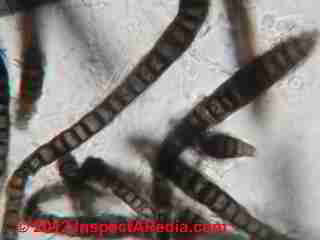 Taeniolella sp. - allergenic and medical data not known.
Taeniolella sp. - allergenic and medical data not known.
This is a stunning, huge septate spore that we often find on plywood subflooring where there have been water leaks and rot such as below a bathroom or at a leaky sliding glass door.
Our Taeniolella photo at left is probably T. phialosperma.
Talc: Talc may be a respiratory dust hazard, depending on its source and contents.
See details at ASBESTOS in TALCUM POWDER
See New York State Tremolitic Talc and Asbestos. Other sources, including the talc industry, disagree.
See Does talc inhalation pose a risk of lung cancer to humans [which is a Talc industry document]. Also see Clay, Talk, Nephaline syenite, Cornwall Stone.
Teleomorph: the sexual (perfect) state of a fungus (ascomycete or basidiomycete) whose spores are produced by meiosis. - Illus. Dictionary of Mycology, Ulloa and Hanlin.
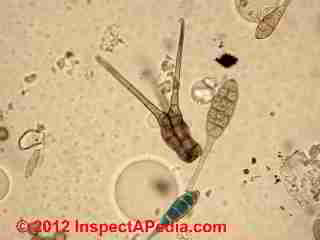 Tetraploa sp.: e.g. Tetraploa aristata.
Tetraploa sp.: e.g. Tetraploa aristata.
The species has been reported as an agent of keratitis and subcutaneous infection. - Atlas of Clinical Fungi, deHoog et als.
We find instances of this spore in outdoor and occasionally indoor air samples. - DJ Friedman (Photo at left shows a Tetrapoloa sp. spore at center along with some Alternaria, one of which picked up lactophenol cotton blue stain.)
Note that we don't always see four (tetra) legs on the spore, depending on several variables including spore position and microscope focus.
Phaeohyphomycotic cyst caused by Tetraploa aristata. Markham WD, Key RD, Padhye AA, Ajello L. Department of Pathology, Flowers Hospital, Dothan, Alabama 36302. "A case of phaeohyphomycotic cyst on the left knee of a 54-year-old man caused by Tetraploa aristata is described.
Identification was based on the coloration and morphology of the fungus in tissue and the macro- and micro-morphologic characteristics of the mould isolated from the cyst fluid.
T. aristata is a dematiaceous hyphomycete found on the leaves and stems of a variety of plants.
Previously, it has been known as an etiologic agent of two human cases of keratomycosis.
This article describes the first known subcutaneous phaeohyphomycotic infection caused by T. aristata." -- www.ncbi.nlm.nih.gov
Torula sp. -(photo, left) reported to be allergenic and a possible cause of hay fever and asthma.
Trichocladium uniseptatum: no medical information available.
Check websites at U. Minnesota and U. Adelaide for updates which may add data on this genera and species.
I have found this fungus in a number of building inspections where there was leak damage and wood rot present.
Trichocladium asperium is a wood rotter, and occasional cases of keratitis were reported - Atlas of Clinical Fungi, 2nd Ed. p.941.
Trichoderma sp. - It is commonly found in soil, dead trees, pine needles, and paper, unglazed ceramics
. It often will grow on other fungi. It produces antibiotics which are toxic to humans. Trichoderma sp. has been reported to be allergenic. It readily degrades cellulose. U. Minn.
These spores are spread by air transport. "[Cases of human] infections with Trichoderma are rare but increasing numbers have been reported.
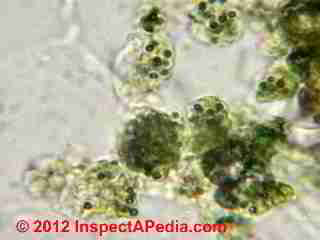
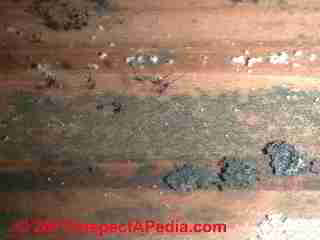
Trichodema species we often encounter in buildings are T. harzianum (green globose spores) and T. koningii (green ellipsoidal spores); also T. polysporium (generally white) which looks like greenish clumps of grapes and also shows up clearly in mite or some other insect fecal pellets when mites or other insects are feeding on the mold - shown in our photo at above left (at 100x).
No stain was used in slide preparation. Our Trichoderma photo at above right illustrates this mold fungus growing on wood surfaces in a basement.
Some microscopists refer to the green species of Trichodemra as T. viride.
Trichoderma fungus has been associated with hyalohyphomycosis and has been reported from nosocomial [hospital-acquired] infections traced to contaminated solutions. Grows at 25-30degC. " - Fundamentals of Diagnostic Mycology, Fisher/Cook.1998.
Often found in buildings, esp. T. harzanium (per W. Zabel's key); other species include T. koningii and T. polysporium; I find T. viride in many indoor samples on pine T&G subfloor over wet crawl spaces or basements-DF
Trichophyton sp.: Can cause ring worm, athlete's foot, skin, nail, beard and scalp, found in soil and on skin. [Op.Cit. Mould Allergy , Yousef Al-Doory et als.] 6). Reported to be allergenic [Op.Cit. Burge, H.A. 1985. "Fungus allergens,"]. Found on soil and skin - U. Minn.
Trichothecium sp.: 0.90 Conidia dimensions 12-23 x 8-10u. Found in decomposing vegetation, soil, corn seeds and in flour.
The species Trichothecium roseum can produce a trichothecene toxin which may be associated with disease in humans and other animals [Op.Cit. Mould Allergy , Yousef Al-Doory et als.]. Reported to be allergenic [Op.Cit. Burge, H.A. 1985. "Fungus allergens,"]. - U. Minn.
Tritarachium sp: this is a common, cosmopolitan saprobe (wood rotter) commonly found on decaying plant or wood material and on water-damaged materials. It has not been reported as a source of infection or human illness according to A Clinical Laboratory Handbook, St. Germain & Summerbell. However T. oryzae as an airborne spore which has been associated with corneal ulcers.
It was also isolated from a case of otomycosis, Atlas of Clinical Fungi, de Hoog et als.
Reported to be allergenic [Op.Cit. Burge, H.A. 1985. "Fungus allergens,"] according to U. Minn. In sum, it might be a source of fungal eye infection or eye ulceration - paraphrased by DJF.
Truffles, see Tuber melanosporum - Black Truffle
Tuber melanosporum - Black Truffle, or Black Périgord Truffle: truffles, a food delicacy sought by humans, and as well by animals who are attracted by sex hormone mimicking odors produced by black truffles and white truffles, are the fruiting body of a symbiotic fungus that is itself found in soils near the roots of trees, particularly oak (black truffles), but also beech, poplar, birch, hornbeam, hazel, and pine trees.
The fruiting season of this fungus group varies by time of year, tree genera/species, and other conditions, and the fruiting bodies, or truffles, are found between leaf and organic litter and soil.
In the New York Times (March 2010) reporter Nicholas Wade provides an accessible, well-written summary of current knowledge and gene decoding research involving Black Périgord Truffle or Tuber malanosporum. Tuber magnatum is the genus and species name for white truffles.
Most truffle species are members of the genus Tuber, and their symbiotic relationship with trees is an extra level of nutrients provided to their host trees by these fungi.
Also see "Basidiomycota truffles: Cup fungi go underground", Karen Hansen.
U
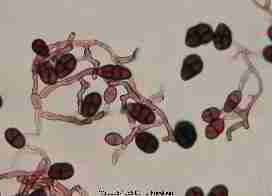 Ulocladium sp. - U. Chartarum is common in house dust and bedding and in HVAC equipment.
Ulocladium sp. - U. Chartarum is common in house dust and bedding and in HVAC equipment.
Related to Alternaria, and along with Stemphylium, it is among the most common mold allergens. -- Hoffman in 3 p. 109 per labspec.co.za 8/01; also can cause hay fever and asthma and rarely, subcutaneous tissue infection. --
Most Ulocladium species are soil fungi and they are rarely seen in the clinical laboratory. But they are found in house dust and mold growth.
Clinical group: Saprophytes Mycosis: Dematiaceous hyphomycetes - U. Adelaide. Common on water-damaged materials, drywall, paper, vinyl wallpaper, paint, plaster walls.
"Ulocladium is known to be a common airway allergen, causing Type I allergies such as hay fever and asthma - one of the most common mold allergens in the United States.
- also known to be a rare cause of subcutaneous infections and phaeohyphomyces (a mycotic infection caused by a dematiaceous conidial mold where the tissue morphology of the causative organism is mycelial) in immuno-compromised patients.
Ulocladium's ability to produce mycotoxins is not clearly known."- EM Lab Dr. Srivandana Kilambi 8/04.
Common in kitchens and bathrooms; U. botrytis common on window sashes/jambs.U. atrum proffered no medical data on my search; this species is commonly found growing on wood; in absence of other data it is reasonable to presume that it may be allergenic as is U. chartarum. -DJ Friedman
V
 Verticillium sp.: Conidia dimensions 2.3-10 x 1-2.6u.
Found in decaying vegetation, on straw, soil and
arthropods [Op.Cit. Mould Allergy , Yousef Al-Doory et als.].
Verticillium sp.: Conidia dimensions 2.3-10 x 1-2.6u.
Found in decaying vegetation, on straw, soil and
arthropods [Op.Cit. Mould Allergy , Yousef Al-Doory et als.].
A rare cause of corneal infections [Op.Cit. Medically Important Fungi - A Guide to Identification] . - U. Minn.
Verticillium fungus is a common parasite on other fungal colonies. We have found Verticillium sp. with Aspergillus sp. and Stachybotrys chartarum.
If Verticillium is found at substantial levels on indoor surfaces the investigator should be alert for the presence of other fungal colonization as well. - DJF
Our photo (above left) shows a Verticillium-like fungal colony collected in a building.
WXYZ
Wallemia sp. (W. serbi) - Found worldwide in house dust, air samples, dry foodstuffs and soil.
Wallemia attacks materials with low water activity, is an allergen and may produce mycotoxins.
It is known to grow on materials with high salt content. www.restcon.com/links/articles/mold_and_mildew.html 0.75 Conidia dimensions 2.5-3.5u
Found in sugary foods, salted meats, dairy products, textiles, soil, hay and fruits [Op.Cit. Smith's Introduction to Industrial Mycology] [Op.Cit. Mould Allergy , Yousef Al-Doory et als.] - U. Minn.
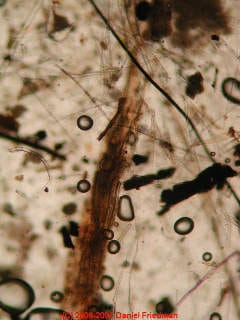
World Trade Center Collapse Dust from the WTC twin towers collapse on 9/11/2001 -
See World Trade Center Dust Particle Photographs - microscopic photos of dust created by the World Trade Center Collapse following the 9/11/2001 terrorist attack on the United States
Yeast - Yeasts are simple unicellular forms of fungi. Various yeasts are commonly identified on air samples. Some yeasts are reported to be allergenic [Op. Cit. Burge, H.A. 1985. "Fungus allergens,"].
They may cause problems if a person has had previous exposure and developed hypersensitivity's.
Yeasts may be allergenic to susceptible individuals when present in sufficient concentrations (E) -- U. Minn.
Reader Comments, Questions & Answers About The Article Above
Below you will find questions and answers previously posted on this page at its page bottom reader comment box.
Reader Q&A - also see RECOMMENDED ARTICLES & FAQs
On 2020-07-29 by (mod)
Really? Sorry Anon but your suggestion is absolutely without any basis in fact, science, nor expert knowledge.
On 2020-07-29 by Anonymous
If you want to find out if you have black mold in your house or building. Fill your kitchen sink half full of water and don't put soap dish detergent in it. Then turn on your furnace on and let it blow throughout the building overnight. Or for a few hours. Then look at the top of the water to see if any small mold spores are floating on the top of the water.
On 2020-07-29 by Regie Brace
@Ryan,
Will black mold cause alligator skin? Will it infect the uterus of a person? I have both symptoms.
On 2020-07-28 by (mod) - camper mold contamination: mushroom growing in carpeted floor corner
Chris
If there is more than 30 sqft of contiguous mold youll need a professional - otherwise, if there's just a small wet area where we see that dried out mushroom - the fruiting body of mold contamiantion, you can perhaps do the clean-up yourself.
Remove the moldy materials
Clean the exposed surfaces
Find and fix the leak in your camper
On 2020-07-27 by Chris
Found this in my camper .Is this something I can take care of or do I need a professional
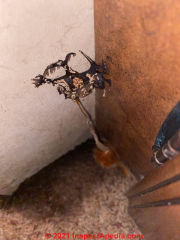
On 2020-02-04 - by (mod) -
SB
Thanks for the mold culture test kit question:
While one could make a wild guess (Aspergillus and Penicillium as those are two ubiquitous indoor molds), nobody can tell you what those two molds are in your culture plate just by looking at the photo. Microscopic examination would be needed.
The good news is it doesn't matter, since if your home is mold contaminated, knowing the genera/species won't change what is needed one iota: find the mold, remove it, and fix the reason it grew in the building.
The bad news is that the "test kit" you used is fundamentally unreliable as a screen for building mold, and the mold in the dish might not even represent what's in the building or not what's dominant in the building.
See details at MOLD CULTURE TEST KIT VALIDITY
On 2020-02-04 by S.B. Greensboro NC
What kind of mold is this? I used a home test kit from Home Depot to check for mold because my family is constantly wheezing in our rental. I took an indoor air quality test with the kit.
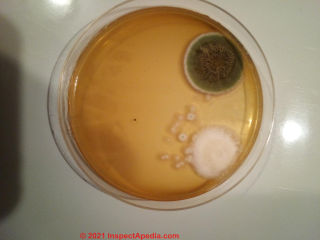
On 2018-11-08 - by (mod) -
Great photo, Ryan; I'm sorry to report that I can't reliably identify a white water fungus from just the photo alone;
In fact it could also be or be closely-related to an algae. White water mold, usually in a tissue-like form, is an Oomycete, a type of Stramenopile in the Domain of Eukaryota.
IF it's an oomycete, it is more related to Yellow Algae, also a Stramenopile. - Thanks to United Chemical commentary found at https://support.unitedchemicalcorp.com/portal/kb/articles/algae-bacteria-and-fungus#White_Water_Mold
None of that is useful information in deciding if your building has a mold contamination problem. The spores that landed on your culture plate could just as easily come in a window or door or could have fallen off or your clothing.
On 2018-11-08 by Ryan
Hi, I was wondering if anyone here could help me identify this. I suspect that it is some variety of water mold, but I am unsure.
It was originally growing in one central mass about 7cm x 7cm, attached directly to the polystyrene lining inside a toilet tank, and completely immersed under water. I transported it to mason jar for better pictures.
IMAGE LOST by older version of Clark Van Oyen’s Comments Box code - now fixed. Please re-post the image if you can. Sorry. Mod.
...
Continue reading at MOLD by MICROSCOPE or select a topic from the closely-related articles below, or see the complete ARTICLE INDEX.
Or see MOLD ATLAS & PARTICLES ID FAQs - questions & answers posted originally on this page
Or see these
Recommended Articles
- MOLD CONTAMINATION IN BUILDINGS - home
- MOLD GROWTH on SURFACES, PHOTOS
- MOLD APPEARANCE - WHAT MOLD LOOKS LIKE - home
- MOLD EXPOSURE STANDARDS - guide to mold exposure levels, mold counts, mold exposure standards world-wide
Suggested citation for this web page
MOLD ATLAS & PARTICLES INDEX at InspectApedia.com - online encyclopedia of building & environmental inspection, testing, diagnosis, repair, & problem prevention advice.
Or see this
INDEX to RELATED ARTICLES: ARTICLE INDEX to MOLD CONTAMINATION & REMEDIATION
Or use the SEARCH BOX found below to Ask a Question or Search InspectApedia
Ask a Question or Search InspectApedia
Questions & answers or comments about the health effects of individual mold genera/species: which building molds cause or contribute to which illnesses?
Try the search box just below, or if you prefer, post a question or comment in the Comments box below and we will respond promptly.
Search the InspectApedia website
Note: appearance of your Comment below may be delayed: if your comment contains an image, photograph, web link, or text that looks to the software as if it might be a web link, your posting will appear after it has been approved by a moderator. Apologies for the delay.
Only one image can be added per comment but you can post as many comments, and therefore images, as you like.
You will not receive a notification when a response to your question has been posted.
Please bookmark this page to make it easy for you to check back for our response.
Our Comment Box is provided by Countable Web Productions countable.ca
Citations & References
In addition to any citations in the article above, a full list is available on request.
- See our complete article at MOLD CLINICAL REFERENCE TEXTS. Excerpts below.
- "Unearthing the Sex Secrets of the Perigord Black Truffle", Nicholas Wade, The New York Times, 29 March 2010, p. A-11
- "Ascomycota truffles: Cup fungi go underground", Karen Hansen, Newsletter of the FRIENDS of the FARLOW. Harvard University \ - http://www.huh.harvard.edu/collections/fof/newsletters/newslspring2006.pdf . Local archival copy is also provided here at Ascomycota truffles.
- Atlas of Clinical Fungi, 2nd Ed., GS deHoog, J Guarro, J Gene, & MJ Figueras, Centraalbureau voor Schimmelcultures, Universitat Rovira I Virgili, 2000, ISBN 90-70351-43-9
The Atlas of Clinical Fungi is also available on CD ROM - Bentley, Ronald, & Thomas G. Chasteen (2002). "Microbial Methylation of Metalloids: Arsenic, Antimony, and Bismuth". Microbiology and Molecular Biology Reviews. 66 (2): 250–271. doi:10.1128/MMBR.66.2.250-271.2002. PMC 120786. PMID 12040126.
- Clinical Microbiology and Infectious Diseases: An Illustrated Colour Text, W. John Spicer MBBS(Melbourne) FRACP FRCPA FACSHP FASM DTM&H(Sydney) DipBact(London), Churchill Livingstone; 2d Ed, 2007, ISBN-10: 0443103038, ISBN-13: 978-0443103032
- Mycology, Fundamentals of Diagnostic, Fran Fisher, Norma B. Cook, W.B. Saunders Co. 1998, ISBN 0-7216-5006-6
- Fungi, Identifying Filamentous, A Clinical Laboratory Handbook, Guy St-Germain, Richard Summerbell, Star Publishing, 1996, ISBN 0-89863-177-7 (English)
See Aerobiology, Building Science, Microscopy, & Laboratory References for our in-lab bibliographical resource list. Other useful references for mold, allergens, and medical effects are listed below.
- A Clinicians's Guide to Fungal Disease, Stephen O.B. Roberts, R.J. Hay and D.W.R. Mackenzie, Marcel Dekker, Inc., New York, New York, 1994. 252p.
- Air Sampling Instruments for the Evaluation of Atmospheric Contaminants, 7th edition, Susanne V. Hering, Tech. Ed. American Conference of Governmental Industrial Hygienist, Cincinnati, Ohio, 1989.
- Dictionary of the Fungi, Ainsworth and Bisby's Dictionary of Fungi [Hardcover]
P. M. Kirk (Editor), P. F. Cannon (Editor), J. C. David (Editor), J. A. Stalpers (Editor),CABI; 9th Ed, 2001, ISBN-10: 085199377X, ISBN-13: 978-0851993775
This is the one essential handbook for all who work with or are interested in fungi (including lichens, slime moulds and yeasts). This new edition, with more than 20,500 entries, provides the most complete listing of generic names of and terms used to describe fungi available. For each genus, the authority, the date of publication, status, systematic position, number of accepted species, distribution, and key references are given. Diagnoses of families, orders and higher categories are included for most groups. In addition, there are biographic notes, information on well-known metabolites and mycotoxins, and broad accounts of almost all pure and applied aspects of the subject (including citations of important literature). All information has been updated as necessary since the publication of the eighth edition in 1995. In addition the ninth edition has the following new features: a refined classification of fungal phyla reflecting the latest molecular evidence, including a major revision of the classification of the Ascomycota; a full integration of anamorphic genera in the classification; a revised synopsis of the proposed classification. - Fungal Biology, Jim Deacon, Blackwell Publishing 2005 and [slime molds] and [common wood rotting basidiomycota]
- Guide to Clinically Significant Fungi, Deanna Sutton, Annette W. Fothergill, and Michael G. Rinaldi, Williams & Wilkins 1994
- ENVIRONMENTAL HEALTH & INVESTIGATION BIBLIOGRAPHY - our technical library on indoor air quality inspection, testing, laboratory procedures, forensic microscopy, etc.
- Adkins and Adkins Dictionary of Roman Religion discusses Robigus, the Roman god of crop protection and the legendary progenitor of wheat rust fungus.
- Kansas State University, department of plant pathology, extension plant pathology web page on wheat rust fungus: see http://www.oznet.ksu.edu/path-ext/factSheets/Wheat/Wheat%20Leaf%20Rust.asp
- A BRIEF GUIDE to MOLD, MOISTURE, and YOUR HOME, [PDF] U.S. Environmental Protection Agency US EPA - includes basic advice for building owners, occupants, and mold cleanup operations. See http://www.epa.gov/mold/moldguide.htm
- US EPA - MOLD REMEDIATION in SCHOOLS & COMMERCIAL BUILDINGS - - US EPA
- US EPA - UNA BREVA GUIA a MOHO / HONGO - en Espanol
- A BRIEF GUIDE to MOLD, MOISTURE, and YOUR HOME, [PDF] U.S. Environmental Protection Agency US EPA - includes basic advice for building owners, occupants, and mold cleanup operations. See http://www.epa.gov/mold/moldguide.htm
- "Disease Prevention Program for Certain Vegetable Crops," David B. Langston, Jr., Extension Plant Pathologist - Vegetables, University of Georgia (PDF document) original source: www.reeis.usda.gov/web/crisprojectpages/209797.html
- Disease Prevention in Home Vegetable Gardens [PDF], Patricia Donald,Department of Plant Microbiology and Pathology,
Lewis Jett
Department of Horticulture, University of Missouri Extension - extension.missouri.edu/publications/DisplayPub.aspx?P=G6202 - "Management of Powdery Mildew, Leveillula taurica, in Greenhouse Peppers," Ministry of Agriculture and Lands, British Columbia - Original source: www.agf.gov.bc.ca/cropprot/peppermildew.htm
- Fifth Kingdom, Bryce Kendrick, ISBN13: 9781585100224, - we recommend the CD-ROM version of this book. This 3rd/edition is a compact but comprehensive encyclopedia of all things mycological. Every aspect of the fungi, from aflatoxin to zppspores, with an accessible blend of verve and wit. The 24 chapters are filled with up-to-date information of classification, yeast, lichens, spore dispersal, allergies, ecology, genetics, plant pathology, predatory fungi, biological control, mutualistic symbioses with animals and plants, fungi as food, food spoilage and mycotoxins.
- Fungi, Identifying Filamentous, A Clinical Laboratory Handbook, Guy St-
- US EPA: Mold Remediation in Schools and Commercial Building [Copy on file at /sickhouse/EPA_Mold_Remediation_in_Schools.pdf ] - US EPA
- Mycology, Fundamentals of Diagnostic, Fran Fisher, Norma B. Cook, W.B. Saunders Co. 1998, ISBN 0-7216-5006-6
- In addition to citations & references found in this article, see the research citations given at the end of the related articles found at our suggested
CONTINUE READING or RECOMMENDED ARTICLES.
- Carson, Dunlop & Associates Ltd., 120 Carlton Street Suite 407, Toronto ON M5A 4K2. Tel: (416) 964-9415 1-800-268-7070 Email: info@carsondunlop.com. Alan Carson is a past president of ASHI, the American Society of Home Inspectors.
Thanks to Alan Carson and Bob Dunlop, for permission for InspectAPedia to use text excerpts from The HOME REFERENCE BOOK - the Encyclopedia of Homes and to use illustrations from The ILLUSTRATED HOME .
Carson Dunlop Associates provides extensive home inspection education and report writing material. In gratitude we provide links to tsome Carson Dunlop Associates products and services.


